
South Coast Orchid Society, Inc. is a tax-exempt 501(c)(5) organization promoting the cultivation, appreciation, and conservation of orchids. We were founded in 1950 by local orchid hobbyists and growers. We are an affiliated society of the American Orchid Society (AOS) and of The Orchid Digest Corporation (from October 11, 1953 to the present). Our main activities, including our monthly meetings and our annual auction, are open to the public. For information about donations, please contact us!

Members bring plants for ribbon judging
We meet monthly, usually on the fourth Monday of the month, unless there is a conflict due to holidays or inavailability of the meeting hall, at Whaley Park, 5620 Atherton Street, in Long Beach, California. The program presented by our featured speaker begins at 7:30 pm — see the current newsletter for details! However, one of the highlights of our meetings, and a good reason to arrive by 7:00 pm, is the astonishing assortment of blooming plants that our members bring for informal ribbon judging. Most of these plants have been grown outdoors by our members! In addition, there is usually a silent auction for a few selected plants, and, at the end of the meeting, a raffle for plants donated by vendors or individuals to benefit the society. One of the best ways to learn about orchids is to spend some time examining the plants at our meetings, and discussing them with other members.
For more information on topics that have been discussed in our meetings, see our blog, Orchids Today and Yesterday. We are also looking for pictures of our meetings, past and present, as well as any stories, newspaper clippings, etc. that you may have collected, for possible use on our web site and other publicity activities. Please contact the web master.
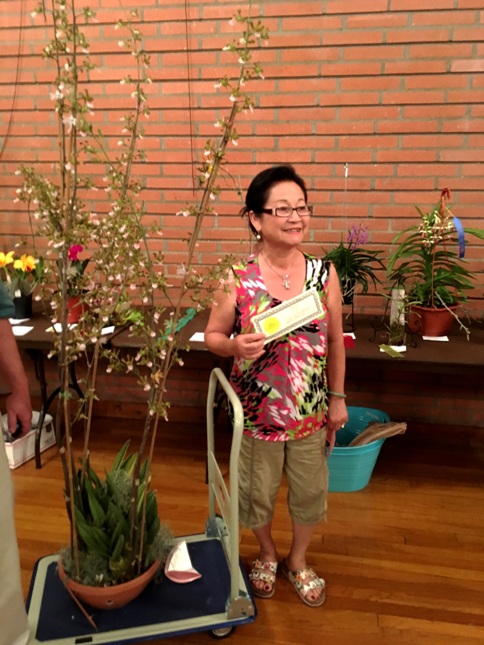
Agnes and her award-winning Eulophia
In conjunction with our meetings, the society also hosts a formal judging center under the auspices of the American Orchid Society. The AOS judging program recognizes orchid plants of exceptional merit. Plants are brought in for judging by some of the best growers in our area, amateurs as well as professionals. The judging center is open for visitors, an excellent opportunity to see what judging is all about, and also an opportunity to see some truly exceptional plants.
There's more information about our judging center here.
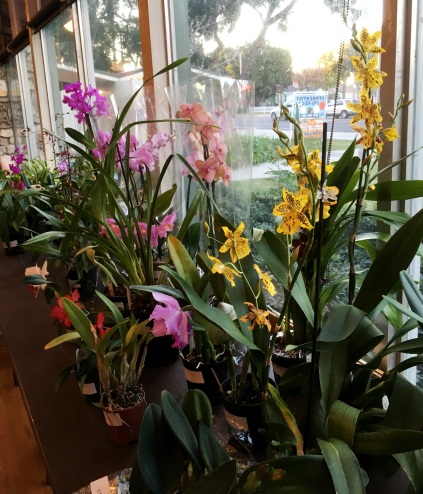
Plants lined up for 2017 auction
Every October, we devote our meeting to our annual auction, our main fund-raising event of the year. The proceeds from the auction help us pay for the activities of the society, such as the rent for the meeting hall (including the AOS judging center) and fees for speakers. The annual auction usually includes hundreds of plants of many types, donated by local vendors and individuals, most of them suitable for growing at home. Among the plants being auctioned, there are often divisions of very desirable species and hybrids that are not usually available at nurseries.
Please see our separate web page about the SCOS 2019 Annual Auction for the latest information. We expect to resume the annual auctions in 2022.
Our Presidents

We recovered the names of our past presidents from old newsletters and the few surviving membership rosters. We honor our predecessors for their care in creating a legacy of service to everyone who enjoys orchids today. Little by little, more details of their lives and times have been discovered.
At first, it seemed we would end up with nothing more than a list of people interested in orchids. However, as we dug deeper, the story took some unanticipated turns. Our presidents, like the still poorly-known roster of our past members, came from many different backgrounds. There were veterans of numerous wars, engineers and pilots in the thriving aviation industry of Southern California, oil men, doctors, veterinarians, software engineers, salesmen, people from the entertainment industry, the horticulture and agriculture industries, entrepreneurs... in short, representatives of every sort of Southern California story. They were affected, too, by all of the usual Southern California challenges: traffic, real estate prices, freeways, shopping malls, parking lots, and above all, the constant threat that "development" would overrun and obliterate all the things that made their lives enjoyable. Somehow, each generation has adapted. Our presidents succeeded in their mission: we still have our orchids!
1950, 1951: Paul Noble Baker, 1892-1961
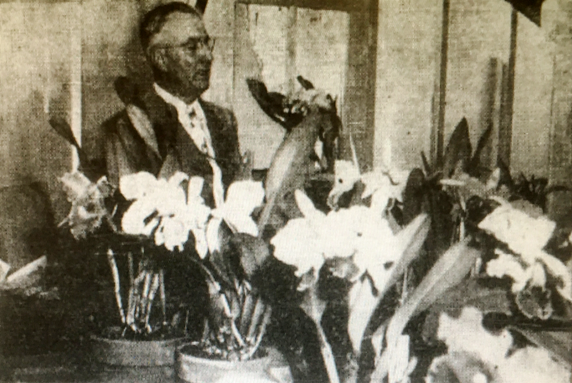
Caption for the photo of our first President, Paul N. Baker, from The Long Beach Independent, December 24, 1950: BAKER’S BLOSSOMS — Oil and orchids are beautifully blended by Paul N. Baker, Long Beach oil man, who lives at 424 Winslow Ave. Adjoining his place of business at 370 E. 37th St. he has a glass house where as a hobby he raises spectacularly beautiful orchids. He is shown here surrounded by a few of his choicest specimens. He is president of the South Coast Orchid Society. Mrs. Baker shares her husband’s enthusiasm and wins awards for her orchid corsages. (Independent Photo by Fred Wilson.)
Born August 17, 1892, El Modena, Orange Co., CA, career in insurance and oil, President, Shasta Petroleum Co., died November 30, 1961. Married Maude Audry Daume May 24, 1941, she was well known for her orchid corsages. Paul liked to enter his orchids in the Los Angeles County Fair at Pomona. He was also a member of Orchid Society of Southern California. We believe his eldest daughter is still living. We would love to find pictures and more information about our first President!
Orchid Digest, September-October 1949, p. 473-474:
CALLING ON PAUL N. BAKER
J. P. SpitzelWe are headed for a visit with Mr. Paul N. Baker, one of our newer members [this refers to Orchid Society of Southern California.—Ed.]. Turning off Long Beach Boulevard at 37th Street, we are rather startled to find ourselves at the very edge of a busy oil field. Oil wells pumping, over there a typical little field office—yes, right here in the midst of it all, two greenhouses. Mr. Baker’s greenhouses are not at his residence, but right among the oil wells. At first this seems rather startling, but when Mr. Baker explained that his backyard at home is too small to indulge in his hobby, and that on the other hand he has quite a bit of time during the day to take care of his plants, it all seems rather simple.
As we expected, we found Mr. Baker repotting and he was making a splendid job of it. His hobby dates back to 1942. His first collection consisted of a dozen miscellaneous cymbidiums, seven laelias and three stray “catts.” Greenhouses were not available during the war, but there was a nice peach tree in the back yard, so the peach tree pinch-hits for a greenhouse and evidently fills the bill well. Such little inconveniences as moving all the plants into the kitchen when a cold spell was predicted did not deter nor discourage an enthusiast like Paul Baker.
Early in 1948 Mr. Baker built his first 10 × 12 greenhouse. Within a matter of months it proved too small and by November of the same year a second greenhouse, slightly larger than the first one, was erected. Now, six months later, plans are under way for another of generous size.
Overhead lath is used in lieu of whitewash. The plants look well. Mr. Baker has his own ideas on potting. He believes in ramming osmunda down real hard in the lower half or two-thirds of the pot, the balance is potted medium hard. He waters every week or ten days, soaking the material well; sprays overhead on every sunny day. He thinks that by pursuing this method of watering he can lengthen the life of the osmunda to three years instead of the usual two. In line with this thought he advocates the use of larger pots to allow for three years’ growth. Some of the mature plants and seedlings are potted in Ashton’s mix. He likes this mix so well that he is experimenting with this material by potting in a combination of half osmunda and half Ashton’s mix.
Another of his experiments is potting the plants in Yucca Cactus Fibre. The cactus fibre is a by-product of water conditioning manufacturers. He claims root action is exceptionally good. Mr. Baker is also attempting to raise the carbon dioxide contents in the air of his house by letting a layer of yucca fibre decay under his benches. He hopes to raise the CO2 to 0.04 of 1%. Normal is supposed to be 0.03 of 1%.
Whenever possible, rainwater is used for watering the plants.
Only one plant was in bloom; an unidentified seedling blooming for the first time, beautiful, dark reddish color, with five flowers.
We thanked Paul Baker for having so generously expounded his theories for the benefit of the readers of the ORCHID DIGEST and we promised to drop in sometime again soon.
Perhaps the reason Baker was interviewed for Orchid Digest is found in a feature published by the Press-Telegram (Long Beach) in the "Southland Magazine" section, Sunday, July 10, 1949, with four photos, which have been digitized with varying degrees of success by several online newspaper archive services:
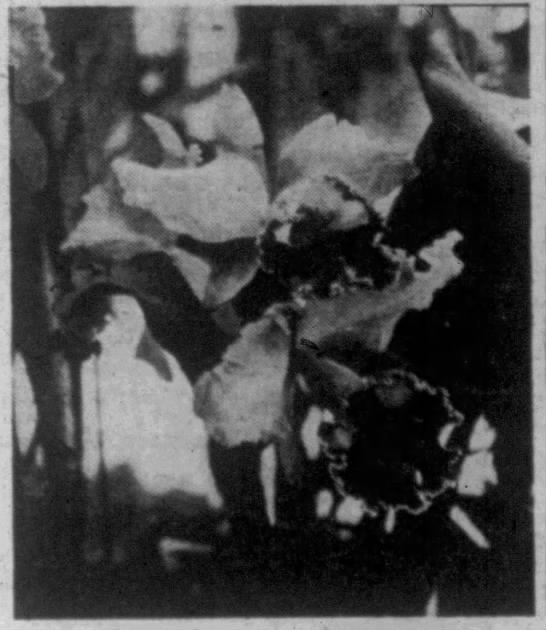
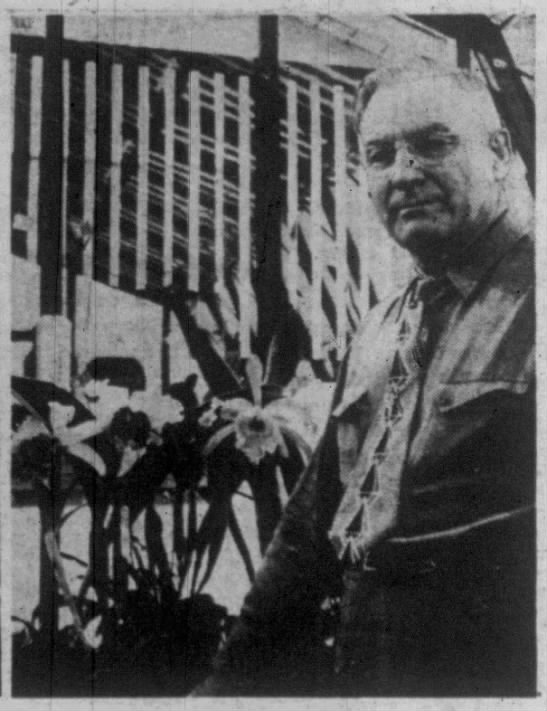
Paul N. Baker of Long Beach grows rare orchids in two small glasshouses. Left above, a cattleya in purple and white, is most preferred orchid for corsages.
Orchids Amid Black Gold. By Donnell Culpepper. Nestled in the midst of a dozen producing oil wells at 370 E. 37th St. are two tiny glasshousees containing a $2000 collection of orchids. Those little houses are the pride and joy of Paul N. Baker, oilman, who would gladly get up in the middle of the night to see a new bloom on a cypripedium, but who probably would turn over and go back to sleep if someone told him the pump of an oil well had gone silent.
Baker is one of possibly 100 orchid fanciers in Long Beach. He spends as much time at his flower hobby as he does at his business.
We have traded yarns with rose, camellia, azalea and pelargonium growers for years, but we have never seen such enthusiasm as that displayed by Baker and other orchid men. There’s something terribly exciting about orchids: When a plant gets ready to bloom after eight or ten years or so from its original seed, it’s really one of those blessed events in the flower kingdom.
There’s something decidedly different about the coloring of orchids. The browns, reds, orange-yellows, purples, whites, blues and golds seem to take on a distinction of their own that can’t be matched by any other flower. That’s strictly a layman’s viewpoint. The orchid fancier himself really goes into ecstacy over the rare plants.
Getting down to earth with the orchids, their culture is easier and less expensive than most flower growers might think. A glass house is essential for the rarer plants. The laelia hybrids (or Mexican varieties) may be grown in the outdoors, under lath-house shade. The cattleya hybrids, which are the favorite plants, the cypripediums, vandas, phalaenopsis and the odontoglossum must be grown in temperature ranging from 58 to 90 degrees. A constant temperature in the upper level is more beneficial to the growing plants. There are such other varieties as dendrobiums, miltonia vexillaria, and phaius.
Baker has two small houses. One is seven by nine feet, the other 10 by 12. In those houses are 100 plants, most of which he bought. Some, however, he obtained by division of plants.
New plants are started in two ways — from division of the roots, or from seed. Naturally, growing plants from seed requires a longer time for blooming. Some varieties bloom in six years; others 10.
Blooms of orchids are exceptionally long lasting, making them ideal for corsages. Some orchid blooms will last nine weeks without wilting.
The factor that makes orchids so expensive is the long period of incubation of the plant. Seedlings must remain in test tubes for two years before they can be removed to community flats or pots. Then in another year, each plant is placed in an individual pot to continue for another four years of growth. Best growing mediums are spagnum moss, osmunda peat and fern root soil.
No fertilizer is needed if temperatures and humidity are kept at the right level. Watering is done about once a week in hot weather, every other week in the winter. It is best to use pure water, preferably water that contains no alkali.
Orchids in hothousees are among the cleanest of plants. They develop no diseases common to many favorites of the garden, and, as each plant is individually potted, there is no weed trouble.
There are orchids worth thousands of dollars per plant, particularly those at Ojai’s famed Orchid Town, owned by Louis M. Boyle of Ojai Valley. One plant at Boyle’s ranch produces 400 blooms each year. These blooms are sold at $2 each.
Baker’s cattleya orchids (the purple and white varieties used in corsages) are among his most valuable. One variety of the cattleya, the Bow Bells, is valued at $800.
Baker first placed heaters in his glasshouses so that he could keep the temperature at an even range. This worked well through the last winter, one of California’s coldest. He found, however, that as warm weather returned, he needed a humidifying system. He finally installed a device that controls temperatures, a fine misty spray and the ventilators on top of the houses. Thermostats control the entire system. We found what he meant by the automatic humidifiers a few seconds after opening a door to one of the houses. Water from the automatic spray struck us head-on before we had time to reach the door.
All of thius sounds complicated and expensive to the average gardener. For orchid growing on a small scale, most of the expense can be eliminated. It is best to start with small plants. The Mexican varieties can be grown in a semishade. They can be hung on the sides of trees, on fences, inside lath-houses or placed in baskets of moss. It is best to start with those cheaper varieties and learn their culture if you don’t have a glasshouse. Later, a person can graduate to the rarer plants, most of which can be purchased in small sizes that may not bloom for two or three years.
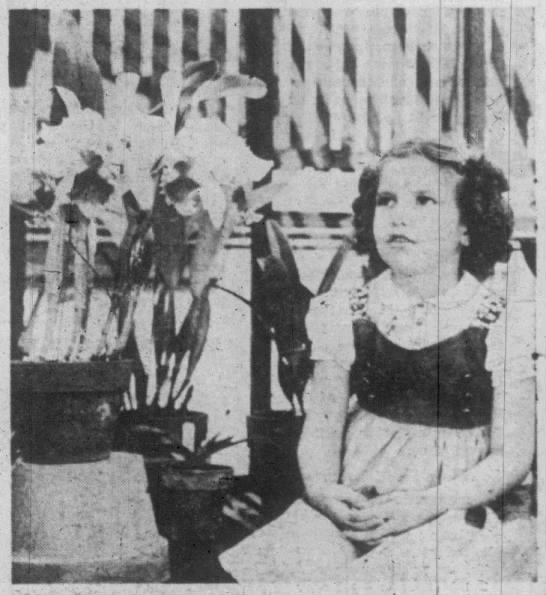
Rosemarie Baker, 7, poses prettily among the orchids in father’s greenhouse in area hedged by oil derricks.
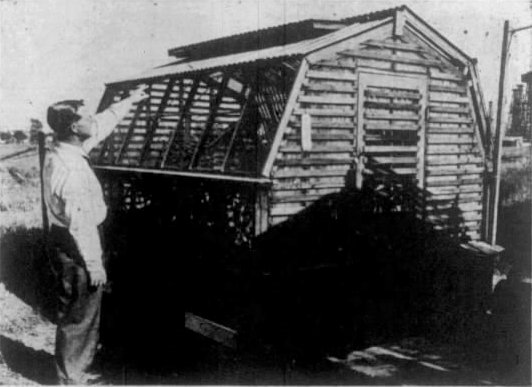
Baker installed his own ventilators on tops of the greenhouses, as shown in photo above. Vents are opened and closed automatically by thermostat control.
Eponymous orchids: Thanks to a list of awards granted by Orchid Society of Southern California 1949-1954 that turned up in the library of the Los Angeles County Arboretum (many thanks to librarian Susan Eubank for leading us to the bundle of OSSC "miscellany", covering 1951-1958, plus a single newsletter from 1970), we have been able to find some of the early awards involving plants exhibited by members of SCOS. At that time, as best we can determine from the extant OSSC newsletters and other records, OSSC had its own judging program, to which were added, at some point, AOS judging and Orchid Digest Corporation judging.
We think we have found the advent of AOS judging on the West Coast, in a notice in the American Orchid Society Bulletin, 1952: "American Orchid Society Judging on West Coast. In an effort to provide increased opportunity for members on the West Coast to have their fine orchids judged for American Orchid Society Awards, the Trustees have appointed Mr. Morris Holmquist, Mr. Jay A. Muller, Mr. Robert Casamajor, Mr. Howard A. Anderson and Dr. Etta Gray as a subcommittee to the Committee on Awards to conduct American Orchid Society Judging in January, April and September 1953, utilizing the facilities of the Orchid Society of Southern California. Certified A.O.S. Judges will officiate and any interested orchid grower in the country may submit plants or flowers. Next date is January 12, 1953. Plants are to be sent to Fiesta Hall, Plummer Park, 7377 Santa Monica Boulevard, Hollywood, California, no later than 7:00 o'clock p.m."
While the designation of specific awards in the OSSC awards list for 1949-1954, such as AM/AOS or FCC/RHS, is inherently ambiguous (we presume the former awards were made during AOS judging at OSSC, while the latter awards were made in England at some unknown date that we should be able to confirm from RHS sources), we think it is reasonable to see in this list a set of plants awarded only by OSSC from its own judging program, and a smaller set that also met AOS criteria starting in 1953. It is still not clear exactly at what point "Orchid Digest Corporation judging" emerged as a specific program with its own, official set of awards. Nevertheless, we spotted Paul Baker in the list several times:
- Sophrolaeliocattleya Meuzac 'Radiance' (Slc. Meuse × Slc. Anzac), Silver, 82.0 points, February, 1951.
- Blc. Ursula 'Magnificum' (B. Digbyana × Lc. Sargon), Bronze, 77.2 points, May, 1951.
- Laeliocattleya (unregistered) 'Rose Marie' (C. Tower × Lc. Red Oak), Bronze, 80.17 points, July, 1951. [This hybrid was registered as Lc. Red Tower in 1949 by Clarelen Orchids, Madison, Wisconsin, operated by Clarence Karl C. Shubert.]
- Laeliocattleya Cuesta 'Paul Baker' (Lc. Cavalese × Lc. Marie Dobrott), Bronze, 76.5 points, November, 1951.
- Dendrobium Phalenopsis 'Bali', cultural award, February, 1952.
1952: Rolan Reid Howard, 1896-1970
Born December 26, 1896 in West Virginia, served in the US Navy in World War I, died January 7, 1970 in Escondido, San Diego Co., CA. Married Nell Grace Marsh June 25, 1921, Snohomish Co., WA. She was born in 1901 in West Virginia and died September 29, 1982 in Huntsville, Alabama. After the death of Rolan in 1970, she had married Paul F. Miller in 1974. Both Rolan and Nell were orchid judges, first under Orchid Digest standards. Rolan was an accomplished photographer, but it turns out that people don't often take pictures of photographers. We have not yet located any pictures of Rolan or Nell.
Eponymous orchids: Cattleya Rolan Howard (C. Nell Howard × Rondel, created and registered by Nell Howard, 1962), Cattleya Nell Howard 'Lisa Ann' HCC/AOS (C. Ballerina × Dorothy Fried, created and registered by Joe Ozzella, 1956). Nell Howard created or registered a number of other hybrids in several genera.
Rolan was the first President of the Escondido Camera Club, which was founded early in 1968. The first slate of officers was installed April 4, 1968 at the club's fourth meeting, at Grant Junior High School in Escondido. From the meeting notices that appeared in the Times-Advocate (Escondido, CA), it would seem his Orchid Digest judging experience carried over into this club; their meetings usually involved judging slides. Rolan was the featured speaker at the club meeting on November 7, 1968: "Rolan Howard will demonstrate photography of flowers at a meeting of the Escondido Camera Club in room 7 of the Grant Junior High School at 7:30 p.m. Thursday. Howard will show how to give flowers character through placement, lighting and manipulation." Rolan served as President until April 3, 1969, when the next club President was installed, at which point he became a Director of the club.
Times-Advocate (Escondido, CA), January 9, 1970: Rolan Howard. ESCONDIDO — Private graveside services for Rolan Reid Howard, 73, of Route 1, Box 771, Nabal Street, Escondido, were held Thursday at Fort Rosecrans Military Cemetery. Mr. Howard, who had lived here the past six years, died Wednesday at Palomar Memorial Hospital. He was born in West Virginia Dec. 25, 1896, and had lived in California for 49 years. He retired about 10 years ago after 45 years' employment with the Western Electric Co. and came here from Hawthorne. Mr. Howard was a World War I veteran and served in the U.S. Navy. He was a past president of the South Coast Orchid Society of Long Beach and president of the Escondido Camera Club. He is survived by his wife, Nell; a daughter, Mrs. James D. Brown, and three grandchildren, all of Escondido.
Times-Advocate (Escondido, CA), October 5, 1982: Nell Howard Miller. ESCONDIDO — Memorial services were held Saturday for Nell Grace Howard Miller, who died Sept. 29 in Huntsville, Ala. She was 81 and a native of Huntsville. She was a descendant of the Crow family, which traces its history in this country back 180 years. A 23-year resident of Escondido, Mrs. Miller was known in the area for her interest in orchids. She was a judge for the American Orchid Society and was a member of the San Diego and Palomar Orchid Societies. Mrs. Miller was a member of the Escondido Camera Club and a patron of the San Diego Zoo and Wild Animal Park. She is survived by her husband, Paul; daughter Mary Jane and son-in-law Dr. James Dacey [ should be Deacy ] Brown, both of Rancho Santa Fe; grandchildren Lisa and Jeff Brown and Jan Fowler; and one great-grandchild, Jessie Fowler. Memorial services were held at the Central Presbyterian Church in Huntsville. Burial was in Huntsville.
1953, 1954: George Dean Field, 1913-1980
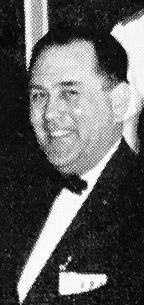
George Dean Field, a very grainy photo from a banquet at the Third Western Orchid Congress, November, 1954. We are still looking for more details on his career, and especially his 4,000 Cattleyas.
We believe he was born in Oklahoma October 26, 1913, moved to the Los Angeles area after World War II, worked as a real estate appraiser in Long Beach, then in Santa Ana, and eventually in the Riverside area, where he died April 23, 1980. President, Orchid Digest Corporation, 1954, 1955. Also served as President of Orchid Society of Southern California, 1957, and held various other offices in all of these groups. He continued to serve the orchid community in Southern California, serving as General Manager for the Southland Orchid Show in 1959. He was likely involved in many more events that have not yet come to our attention.
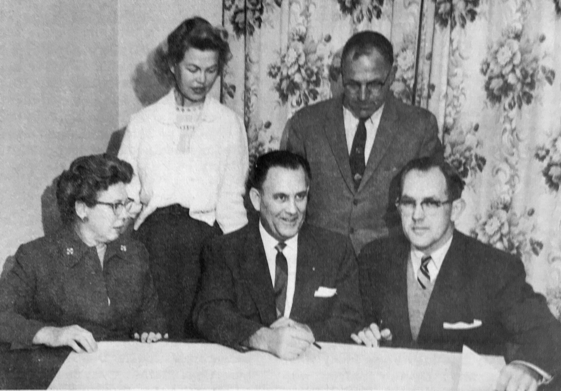
Organizing committee for the Southland Orchid Show, 1959: Seated: Margaret Parmenter, Dean Field (General Manager), Ernest Hetherington. Standing: Margaret Barket, Glen Hiatt
In a newsletter of the Orchid Society of Southern California, June, 1956, at which time Dean Field was First Vice President of OSSC, we spotted a little more information: "DEAN FIELD has been growing orchids for 10 years and has been particularly active in the local orchid societies. He has about 4000 cattleyas, several hundred cymbidiums as well as phalaenopsis, cypripediums, vandas, and a few botanicals. Mr. Field is Past President of South Coast Orchid Society; Past President of the Orchid Digest Corporation; a member of the Cymbidium Society; Chairman of Judging of the American Orchid Society, and First Vice President of our own Society. He is a judge of the Orchid Digest Corporation, a judge of our own Society, and was formerly Judging Chairman of our Society, so he comes well qualified to speak on judging." At that meeting, June 11, 1956, he was to speak on "American Orchid Judging".
In those days, OSSC was meeting in Fiesta Hall at Plummer Park on Santa Monica Boulevard. His 4,000 cattleyas don't seem to be the result of a misprint, and to obtain that many of them in the space of 10 years, he would have had to acquire them at the rate of more than one per day. Truly, he was "particularly active", another early victim of the orchid bug!
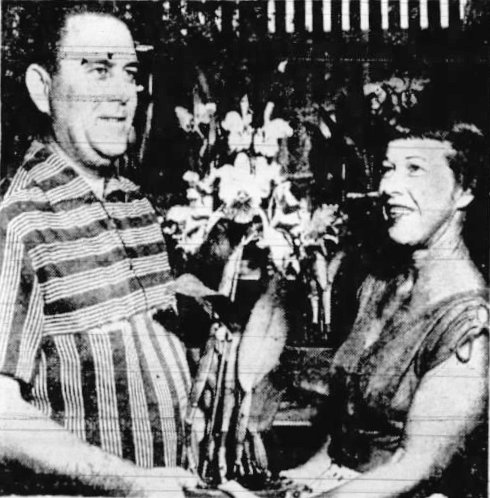
Mr. and Mrs. George Field, photo (apparently digitized from scratched microfilm) from feature article in the Independent Press-Telegram (Long Beach, CA), October 16, 1955, during the run-up to the 1955 Western Orchid Congress: Caption reads, "Typical of Long Beach area orchid growers who plan to display blooms in a big western exhibit here in November are Mr. and Mrs. George Field, with blooms above."
Independent Press-Telegram(Long Beach, CA), October 16, 1955 (Southland Magazine): Court of the Western Orchids. By Betty De Wees. Some orchid fanciers grow orchids in kitchens and bathrooms. Some grow them in greenhouses. Some have one plant, worth perhaps $5. Others have thousands of plants running into many thousands of dollars in value. Orchid growing, they say, has become one of the fastest-advancing hobbies in Southern California. Commercial growers in this area are becoming world leaders in hybridizing orchids. The North [ !!! — error for South ] Coast Orchid Society, which meets at Silverado Park, 31st St. and Santa Fe Ave., on the fourth Monday of each month, will be host to the fourth annual Western Orchid Congress Nov. 10-13 in Municipal Auditorium. Orchid growers from the West Coast and as far away as Tennessee and Oklahoma will attend and the Exhibit Hall of the Auditorium is expected to be filled with orchids. Cattleya, vanda, cypripedium, odontoglossum, pholaenopsis, odontioda and dendrobium orchids will be among the displays. Orchids will range in size from flowers so small they may be seen only through a magnifying glass to handsome orchids nine inches across. Colors will include white, white with purple lips, clear yellow, yellow with red lips, cream with purple lips, rose to red, deep magenta and the deep purple that is almost black. Mr. and Mrs. George D. Field, 5365 Abbeyfield St., typical of Long Beach orchid growers, started with one orchid above the kitchen sink in 1947. Then they expanded to a 10×11-foot greenhouse. Now they have two large greenhouses with 5,000 square feet of glass, 600 blooming-size plants and 3,000 seedlings. The have taken two awards at orchid shows.
More of their story — the amusing way they got started — appeared the next spring:
Independent (Long Beach, CA), March 29, 1956. Anniversary Remembrance. Los Altos Woman Grows Orchids. By David Emery. Because George Field jokingly told his wife to “grow her own corsage” eight years ago, his back yard today is the home of the largest orchid collection in Los Altos. George and his wife, Jean, live at 5365 Abbeyfield St., with two dogs and 600 blooming-size orchids for company. If you toss in seedlings, they’ve got nearly 4,000 orchids in all.
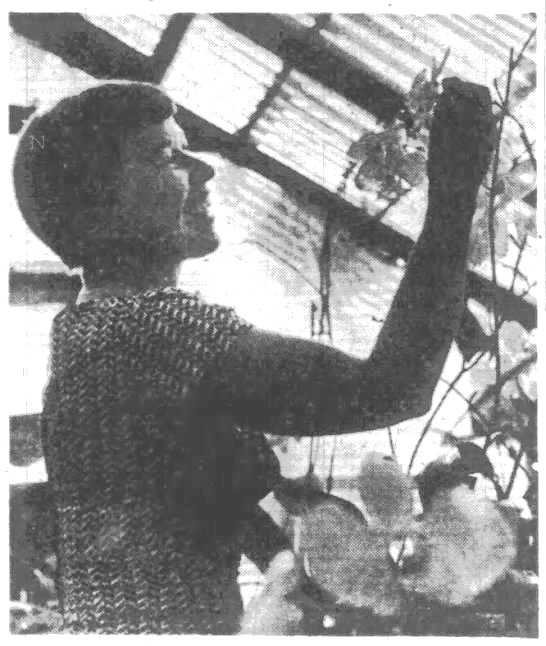
Back Yard of Orchids. Mrs. George Field of 5365 Abbeyfield St., examines a bloom on one of the 600 orchids in her back-yard greenhouse. Mrs. Field and her husband started their collection with one orchid on a window sill above their kitchen sink eight years ago.
“My husband gave me my first plant eight years ago, just before our wedding anniversary,” Mrs. Field explained. “He brought it home from a nursery and said I could grow my own orchid every year.” Mrs. Field says she set the orchid tenderly on the window sill above the kitchen sink and nursed it along for months. But just when it was about to burst into bloom, she moved it to the back porch so the kitchen could be painted. The orchid shuddered and moaned and fell into a state of shock. Today it occupies a place of honor in the Fields’ big greenhouse. It has never flowered.
Undismayed after her defeat, Mrs. Field began collecting orchids in earnest. At first she kept them on an enclosed back porch. When there was no more room, the Fields built a small greenhouse in the back yard. George took up orchid raising, too, and as the collection grew, he extended the greenhouse to its present size of 495 square feet. Automatic controls in the greenhouse raise and close windows, operate water sprays and switch on the fans, holding temperature and humidity to the level of a tropical jungle.
When the orchids are in bloom, the Fields show off their greenhouse treasure to visiting groups of orchid hobbyists and horticulturalists. Both Field and his wife are past presidents of Southland orchid and garden clubs, and Field is currently vice president of the Southern California Orchid Society.
Playing nursemaid to a hothouse full of orchids is a big job. Mrs. Fields works with her plants almost every day. To keep the plants healthy, she burns any orchid that shows a hint of disease and when she clips the flowers, she uses a cutting tool sterilized in denatured alcohol.
Is the expense and bother of raising orchids worth the trouble? The Fields think so. They have more orchids in their back yard than most folks have dandelions. Their yard is a showcase that brings admirers from far and wide. But best of all, Mrs. Field has solved the problem of her wedding corsage for all time to come.
1955, 1956: John W. Hanes, 1908-2005
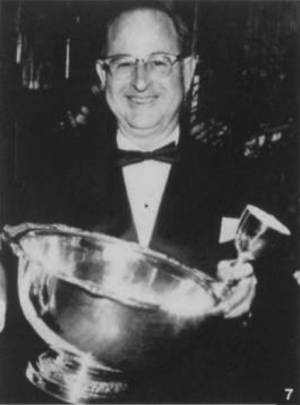
John Hanes with his trophies at the 10th Western Orchid Congress, March 20-22, 1964, Pasadena, CA
Born in Ladonia, Fannin Co., Texas, November 6, 1908, died December 20, 2005 in San Gabriel, Los Angeles Co., CA. He served in the US Navy twice, his first enlistment in 1930, the second in World War II. He and his wife Elva May ("Tommie") (June 9, 1909 - August 25, 1999) were both active in all phases of the orchid world in the Los Angeles area, particularly as judges, first under Orchid Digest and then AOS standards. President, Orchid Digest Corporation, 1959, 1960. He also served as President of the Orchid Society of Southern California, 1960 and 1968.
Obituary: John W. Hanes Jr., died Tuesday afternoon December 20, 2005 at the age of 97 at his home in San Gabriel, California. The oldest son of eight children, he was born and raised on a farm in Ladonia, Texas. He worked in the east Texas oil fields prior to joining the Navy in 1930. During his naval service, he became interested in orchids and other botanical species as a result of a visit to the Royal Botanic Gardens in Trinidad and various shore leave experiences in Southeast Asia, the Philippines and Hawaii. He met and married his wife Elva (a.k.a. Tommie) while stationed in Long Beach, California. They were married for 65 years prior to her death in 1999, and have lived in the same house in San Gabriel since 1949. After leaving the Navy a second time after World War II, he worked in accounting and later sales but soon after he started to raise his family his avocation and second love became raising orchids. His wife Tommie shared his renewed interest in orchids (from his Navy days) and together they were instrumental in establishing the American Orchid Society and were active participants form the mid 1950's through the late 1990's. They were also active in the Orchid Society of Southern California, the South Coast Orchid Society and various other orchid and botanical groups. During this time and after he retired in 1973, John had a small orchid business that had customers visiting his San Gabriel home from all over the world. He won recognition and many awards for his work hybridizing orchids, especially Paphiopedilums (lady slippers). John's work and love of orchids enabled them to travel the world where they made presentations of American and World Orchid Conferences sharing his love, passion and knowledge of Paphiopedilums and other orchids with anyone who was interested. John was loving husband, father, grandfather and great grandfather. He is survived by his son John, two grandchildren Leah and Craig, his great grandson Evan and his youngest sister Georgia Elizabeth who still lives in Texas. He was a good man and will be missed by all. White Emerson Mortuary. (Published in Pasadena Star-News, January 7, 2006.)
Arcadia Tribune, January 21, 1973, in publicity for his lecture to the Cymbidium Society, San Gabriel, Tuesday, January 22: "Mr. Hanes was first introduced to orchids in 1932 while visiting the Royal Botanic Gardens in Trinidad, British West Indies, and had started to grow a few reed epidendrums when World War II interrupted his activities. Soon after his return from service in the U.S. Navy, he again turned to growing orchids, this time in a greenhouse and growing many genera. His specialty is Paphiopediums or Lady Slipper Orchids, especially the hybridization of this exotic flower. His dictum is "To obtain the best results in hybridizing one must start out with the best." And to obtain the best he has purchased top breeding stock from around the world. Mr. Hanes advocates that everyone should have a hobby that related to nature's scheme of growing things, whether it be a few cacti on a window sill or African violets and orchids over the kitchen sink."
John Hanes on Paphs: from The Orchid Collection, newsletter of the Genesee Region Orchid Society, December 1989: Gordon Barringham, “Understanding Paphiopedilums”: John Hanes of Hanes Orchids of Distinction, has conducted careful experiments with a wide range of paph media and concludes that the main differences in growth are found immediately after re-potting. Most plants are growing equally well two years later, regardless of the mix. We amateurs should probably take note that this result was found when all other growing conditions were about as good as humanly achievable. Perhaps the lesson to take home is that many problems in the medium can be compensated for by other cultural conditions, such as water pH, watering schedule or repotting schedule.
(Orchid Digest, 1966, pp. 146-147) Conference Judging with an International Flair. An interview with John W. Hanes. — Has any World Orchid Conference ever used an International Judging System before? The American Orchid Society System was used at the first Conference in St. Louis, in Hawaii, and in Singapore. Or course there was ribbon judging at the shows, but the English Conference, No. 3, used the Royal Horticultural Society form of judging, which is by committee. I understand that some foreign judges were included in the judging sessions at that conference.
Actually, no international form of judging was used before the Conference here in Long Beach. There were a few judges from various parts of the world that were invited to participate in the judging at the other conferences, but it was basically AOS judging here or RHS judging in England.
It was after the Third World Orchid Conference that I became interested in a form of judging that might unite the better qualities of all the judging systems. For the World Orchid Conference should certainly operate with an international form of judging. This would give judges from all over the world a chance to participate.
At that time I discussed this idea with several of the local judges and talked about the possibilities of unifying the judging systems into a form that would make possible an international sytstem at a world orchid conference. We discussed it in general and wrote to judges in other parts of the country, but some of them thought it would be too cumbersom to try to unit the ideas of committee judging and point scoring systems.
At the time that the Orchid Society of Southern California was chosen to be the host society, I went to work to see if we could not have a truly international system of judging. Following the plans and ideas that had been noted in my diary and had been discussed with a number of people, I began to make the recommendations more specific.
When did you finally complete the plans to have international judging? By September, 1965, J. Howard Carrington, Ernest Hetherington and I had pretty well formulated the procedures and policies that were most important in getting the conference judging ready to present to the Conference Committee. We felt that it was possible to incorporate the RHS system of committee judging, the Cymbidium Society of America form, the Australian standard form of judging used in that part of the world, and the Malaysian system. We used the American system of point scoring as a base and extended to other systems as we refined our ideas.
Did the Judging Committee include members from these judging areas? After the Orchid Society of Southern California was chosen to host the Conference—actually all of the societies in Southern California were hosts and participated fully and should be given credit for their support—we sent letters to all judging areas throughout the world to ask their advice and suggest changes to the proposed international system so we could work together. We sent letters to judges in 18 different countries.
How many countries were finally represented in the judging? There were eight countries that produced judges for the judging teams. Including the artistic division, we had roughly 200 judges.
Were the judges able to work together on this system? Actually, the judges found that their objectives of judging were quite similar throughout the world. Some judges are more strict in their evaluation of the flowers than others. We found that this was true from all the areas, and I have found it true with AOS and ODC judges. People who have had more experience in judging and are familiar with a greater number of species and varieties naturally are more apt to be critical of a flower (type and breeding) than persons with less practice in judging.Were there any particular phases of judging that predominated the interest of individual judges? Some judges were more interested in color and scored the plant high for this quality, while others were more apt to score a flower high on form, if it met their idea of perfect shape. Really, there is probably more variation in the eight regional areas of judging in the United States than was noticeable among the judges working at the Conference. The norm for quality was consistent among the judges throughout the world.
What would you suggest to make this system work on a larger scale? What kind of form would you recommend after using the judging procedure in Long Beach? Before you developed a “form for judging,” an international group of judges would have to set some standards and then develop a “system” that would work for all areas. It would have to be a system that would not put a straightjacket on perfection. In a broad sense, appreciation of perfection would be the standard. You know, the Australians have a system for judging commercial flowers that would be worth further investigation along these lines. Back to your question though, the “form” is just an aid in helping judges evaluate the total flower. Perhaps committee judging like the RHS would work if our standards were more completely uniform, but each judging team and area does not have the vast file of colored paintings to refer to as does the RHS. This might be an ideal to work toward, and you know the importance of orchids in color. But you also know the problems of obtaining colored slides that are true to the flower—even after a few years, the color may change.
Would you recommend award pictures to be taken in stereo? Photographic technique and equipment is constantly improving and it certainly would be worth while. It is every expensive to do this kind of work, especially if you were going to do it for all judging areas. This would be most advantageous to the judges. Here again, the three dimensional flower in this special slide device would be costly, but it would be a vast improvement over our present method of having to remember a flower that was awarded ten or more years ago.
I believe we could make large colored pictures from the slides that we normally take and have a reference to a previous award—something like the British have. It would be costly, but very practical to have a set of these pictures for each judging station. You really need documented proof that a former award was of the standard indicated by the awards register. The picture could help you confirm the mental image you retained of the previous award.
Elva ("Tommie") Hanes served as Secretary for SCOS. Thanks to her careful notes about our monthly meetings, which were published in Orchid Digest, we know something about our society at the time we became a judging center for Orchid Digest. An obituary was published in our September, 1999 newsletter: "Tommie Hanes — The South Coast Orchid Society has unfortunately lost one of our earliest, highly dedicated members. Tommie Hanes has been deeply devoted to us since before her husband John was our fourth president 1955-1956, and long maintained an active interest, as well as offices, in the society. Despite her being distanced recently by advancing age, she kept in touch with her many friends. Tommie's longtime service as an AOS judge included efforts, shared with John and other distinguished AOS and ODC folks, such as Ernest Hetherington and Helen Adams, to bring the current form of AOS judging system into being. In recognition of her contributions, the Pacific South Judging Centers proposed that the AOS Trustees give her Judge Emeritus status, granted gladly in 1992. Tommie lived a long and fulfilling life into her 90th year, at least 65 of them in happy company with John. We are glad to have had her share so much of herself with us these many years, and celebrate the memory of her life in orchids"
John was also the first "West Coast Chair of the AOS Committee on Awards" (1962). He was a key figure (along with several other SCOS members) in both the AOS and Orchid Digest Corporation judging programs, and very likely played a role in the eventual merger of these programs at the beginning of 1968. However, nothing about this merger came about seems to have been published, a serious gap in our history. We would like to hear from anyone who has knowledge of these events!
During 1996, Orchid Digest devoted the back cover of each issue to "Digest Doer's Profiles", featuring a portrait and short reflections provided by each of the subjects. John and Tommie Hanes were featured in the July-August-September issue.
DIGEST DOER'S PROFILE
JOHN AND TOMMIE HANES
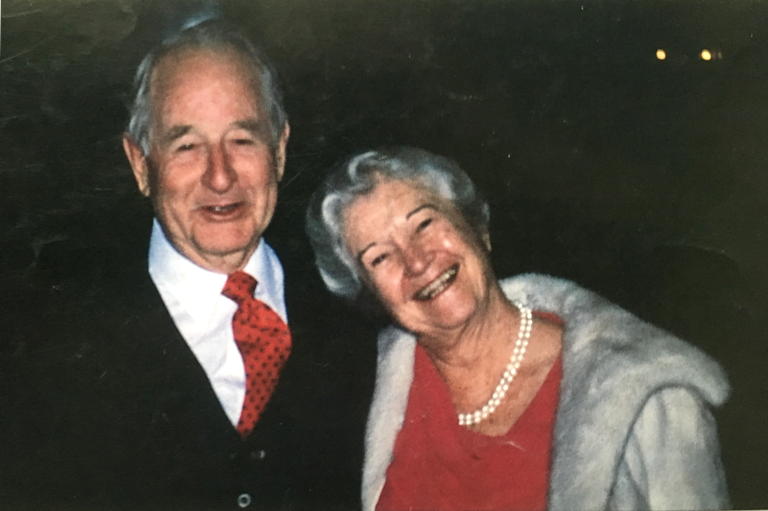
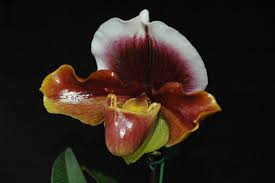
Paph. John Hanes 'Red Star'
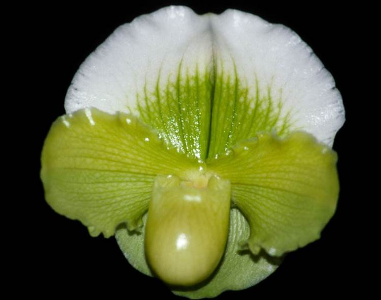
Paph. Tommie Hanes 'Althea' FCC/AOS, AM/AOC
Eponymous orchids: Besides the two Paphs named after John and Tommie, (John Hanes was the originator, they were registered by Rod McLellan & Co.), there are many other orchids associated with the Hanes. John created many hybrids and sold them through his home business in San Gabriel, Hanes Orchids of Distinction. Between 1962 and 1992, John Hanes created at least 658 orchid hybrids that have since been registered, and he also was the registrant for at least 525 hybrids, the vast majority of them Paphs that he created, a phenomenal record.
By far the most successful of his hybrids, however, at least in terms of the number of registered hybrids for which it was one of the parents, was Rlc. Goldenzelle, one of those inevitable crosses involving distinguished parents, in this case Rlc. Fortune × C. Horace. Seedlings of this cross bloomed with big flowers, many of excellent form, in an astonishing array of colors, ranging from lavenders and pinks through various sunset shades to gorgeous pale yellows with subtle shading. At least 30 of these obtained AOS awards. In the next generation, Goldenzelle was the parent of at least 199 registered hybrids, and around a hundred more botanical grandchidren.
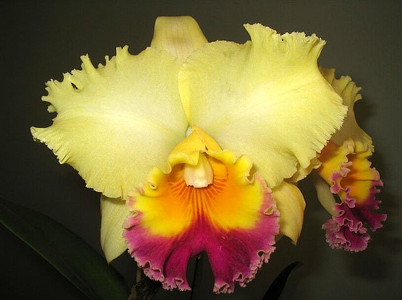
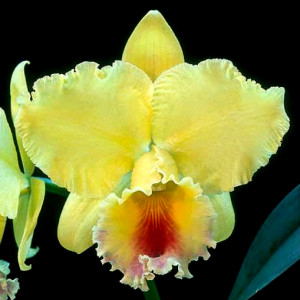
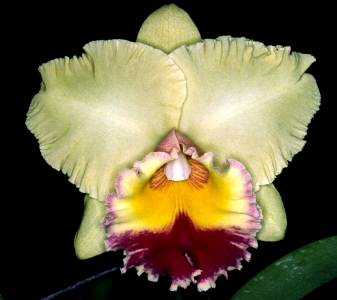
Three cultivars of Rlc. Goldenzelle: 'High Noon', 'Memoria Roy Field' (Roy was a longtime member of SCOS, but keep reading, there's more to this story!), and 'Tokyo'
We can't leave Rlc. Goldenzelle without relating its origin story, preserved by Courtney T. Hackney (2004) in his wonderful volume, American Cattleyas. During his interviews with Norito Hasegawa, Roy Field (both SCOS members), and many others, he learned that at least three growers (Roy Field, Murray Spencer, and John Hanes—all members of SCOS!) had made precisely the same cross, Blc. Fortune 'Golden Throne' × C. Horace 'Maxima', at about the same time. It was one of those inevitable crosses involving clones that happened to catch everyone's attention at the same time, and it would not be surprising to discover that they had traded divisions of the parents at our meetings! Both of these parents were tetraploid, but, for whatever reason, not all of the progeny were tetraploid. While it was John who eventually named and registered the hybrid in 1982, Roy went on to try self and sib crosses with the best of the tetraploid progeny, obtaining a group of spectacular yellows. We might regard this outstanding hybrid as a SCOS group project!
1957: Glenn W. Hamilton, 1915-2009

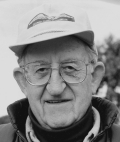
Born December 30, 1915 in Riverside, California, died October 13, 2009 in Arroyo Grande, San Luis Obispo Co., CA. He married Ruth Marcella Smith 1925-1994.
(The Tribune, San Luis Obispo, CA, October 18, 2009:) Long time central coast resident, Glenn Hamilton, 93, son of Fred and Verna Mae Hamilton, died at his Arroyo Grande home on Tuesday, Oct. 13, 2009. He retired from a career in aviation, developed and raised orchids commercially and loved building and flying private planes.
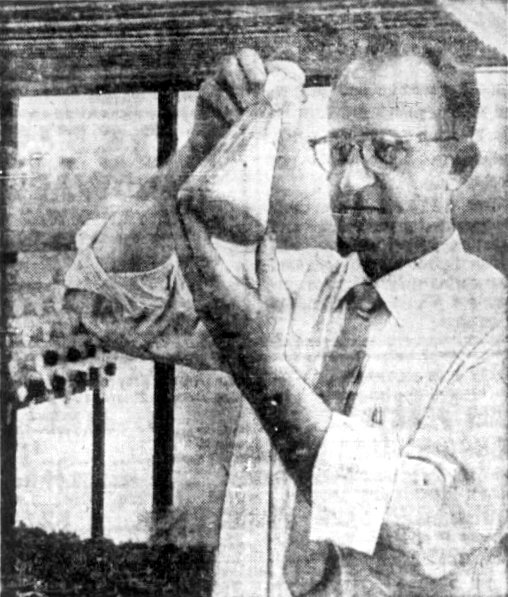
Press-Telegram (Long Beach, CA), May 5, 1957: Orchid Growing Takes Patience. By Vera Williams. Eight years ago 35 persons in the Long Beach area grew orchids. Now there are 500. Orchid-growing, says Glenn Hamilton, 2510 Palm Dr., Signal Hill, president of the South Coast Orchid Society, rapidly is getting to be a popular hobby. "People usually start in the home with a potted orchid someone has given them," he says. "They put it in a pan of wet gravel for humidity. If it blooms, it’s wonderful and they are orchid fanciers. They go to a meeting of some orchid society, and see the orchid plants displayed there. They go home, build a greenhouse or a lath house, get more orchids, and then they are orchid-growers." He paused. "Orchid growing takes patience and room—lots of both."
It takes time to see what a new plant will do. Orchids attract more orchids, it seems, and soon the greenhouse or lath house is full. Hamilton, for instance, had a small collection in 1948. Now he and his wife, Ruth, have 350 blooming-size plants, 2,500 seedlings of advanced sizes, and 20,000 small seedlings. They have three greenhouses with 1,000 square feet of glass. The Hamiltons expect to keep on expanding until they have as many orchids as they can handle, which they think will be somewhere between 5,000 and 10,000 mature plants. They have a full acre on Signal Hill, which should be adequate.
Their favorite is the hybrid cattleya, although they have cymbidiums, dendrobiums, vandas, phalaenopsis and cypripediums, with a scattering of a dozen other kinds. They also grow a variety of reed stem epidendrums which are popular in Southern California.
Orchids have the same requirements as other plants, only in somewhat different amounts, Hamilton says. And they are not parasites, as many persons think. Cattleyas now are grown commonly in screened fir bark in this area, replacing osmunda which was in general use among growers for 40 to 50 years. "Watering is the most critical aspect of orchid-growing for the beginner," says Hamilton. "More orchids are killed by over-watering than all other causes combined." "With most garden plants, withering leaves indicate a need for water. With orchids this seldom is the case. Orchids love to have their roots aired now and then. The compost must be porous enough that water flushes through rapidly. If the roots are kept wet for a prolonged time, they rot off." In fir bark, two copious waterings a week of a mature plant are adequate, while a plant in osmunda requires one good watering a week.
"Orchids may be exposed to rather low temperatures with no adverse effects unless it is for a prolonged time," says Hamilton. A light nip of frost will not kill a mature cattleya, although it will stop its growth for a while. To get good and continuous growth, the temperature should not go below 55 or 60 degrees.
"Orchids grow best in filtered sunlight. Full sun usually will burn a plant. This is especially true of a plant grown in shade and then exposed suddenly to the direct rays of the sun. I have seen orchids turn black and die in 30 minutes in bright, hot sunlight. The shade provided by a lath house is about right. If your plants are grown in the house, a curtain should break the direct sunlight. In a greenhouse, the glass may be painted or lath placed over the glass. Humidity is important, but generally not too much of a problem here in Long Beach. A relative humidity of 60 to 70 percent is ideal. In the house a tray of gravel with water in it usually is sufficient." "In the greenhouse, mist sprayers or simply wetting the walks will keep the humidity high enough," Hamilton explained.
"Cymbidiums are second to cattleyas in popularity. They can be grown under lath without benefit of a glass house. However, they seem to be a little more difficult to bring into flower for the inexperienced grower. Cymbidiums are heavy feeders and should be given light feedings throughout their growing period. Cattleyas require little if any supplemental feeding. Cymbidiums must have good drainage. The hybrid cattleya grown today, the result of multi-generic crossings, is far superior to anything ever grown in the jungle. While hybridizing was conducted at the time of the Civil War, most of the real advances came after the 1920s. A new technique for growing from seed, the bottle culture used today, made it possible for the first time for orchids to be grown from seed in quantity. Orchid hybridizing has accelerated until it has become a multimillion-dollar-a-year business on an international scale."
In an early SCOS newsletter (February, 1958), we found this notice: Seed Sowing. Prompt attention — reasonable rates. G. W. Hamilton, 2510 Palm Drive, Signal Hill, GA 7-0897. He was also chairman of the Orchid Digest Corporation judging center at Long Beach at that time, held during our regular meetings on the fourth Monday of the month. Glenn had just received a letter from a Mr. Johnson in Mexico, who had a collection of about 2,000 plants collected there from the "wild", and offering to sell soon-to-mature seed pods from about a dozen species.
You might wonder if this acre of orchids survived the Hancock Oil Refinery fire of May 22-24, 1958, a huge conflagration only a couple blocks away from Hamilton's house. Apparently the orchids survived, because he was still advertising his flasking services in the SCOS newsletter in 1959, and he still had a listing as a "nurseryman" at that address in the 1966 Long Beach city directory.
Hamilton's was not the only orchid range on Signal Hill. Across the street was the enterprise known as Easthill Orchids, Signal Hill, from which a 1958 nursery catalogue has survived at the UCLA Library (not yet examined). Easthill Orchids registered one hybrid, Cattleya Queen Bee (Dubiosa (1890) × Golden Charm). We found a note in OrchidWiz indicating that Easthill Orchids became William T. Burns Orchids, and we recognize that name. Dr. William T. Burns was an early and very active SCOS member. He later moved to Prince Rupert, British Columbia, Canada, and, eventually, to Colorado. Among the orchids registered by William T. Burns, MD, Orchids was Cattleya Paul Baker (Dorothy Fried × Ennerdale), named for our first president. Surely enough, we found an advertisement in the Press-Telegram, September 25, 1955, William T. Burns Orchids, 2525 Palm Drive, Signal Hill, offering Cymbidium plants starting at $1.50.
In fact, the 60 acre tract around Palm Drive remained "off the grid" in the 1950's, long before that term was invented. By 1954, there were just six homes, described as farms. They were not connected to the gas lines or sewer service but had electricity and telephones. The street was still a dirt road, lined with huge date palms. Residents included a Japanese family (Albert Yasutake) growing flowers, "a Long Beach physician" (William T. Burns) who raised orchids, and a restaurant/nightclub (the Gay Nineties Cafe, which lasted until 1969, although the ear-splitting calliope seems to have been retired after the 50's) that had been a Japanese school prior to World War II. Other residents were Clyde Powell and at least one cow, and L. G. Garret and his guinea hens, chickens, and pheasants. The article about Signal Hill's Palm Drive in the Los Angeles Times, November 7, 1958, includes a nice picture of Dr. Burns and his orchids, which we will save for our planned web page on "SCOS Members and Their Orchids".
Dr. Burns, by the way, did not actually live on Palm Drive. We learned from his daughter Linda, that the property on Palm Drive was only his orchid range, "Easthill Orchids", at one point guarded by Doberman hounds. Dr. Burns, a Navy veteran with expertise in deep-sea diving and "submarine medicine", lived for a few years on Elm Ave., just half a block north of Paul Baker's oil business and greenhouses (see above). Very likely, Dr. Burns caught the orchid bug from Baker and maybe from Hamilton as well. Oil and orchids, a recurring theme in SCOS history.
The Hamilton family must have moved to the house on Mesa View Drive, just above Arroyo Grande, in the early 1980's. Dan Asbell, of Asbell Orchids in Arroyo Grande, told us Glenn had arranged an area under shadecloth next to the house, where he grew mainly Cymbidiums, and later expanded the growing area. Eventually the business was sold to Joe Oosterveer and operated under the name Los Padres Orchid Company. The Los Padres business has since moved to Carpinteria.
1958, 1959, 1969: Charles Edward Bowman, 1907-2003
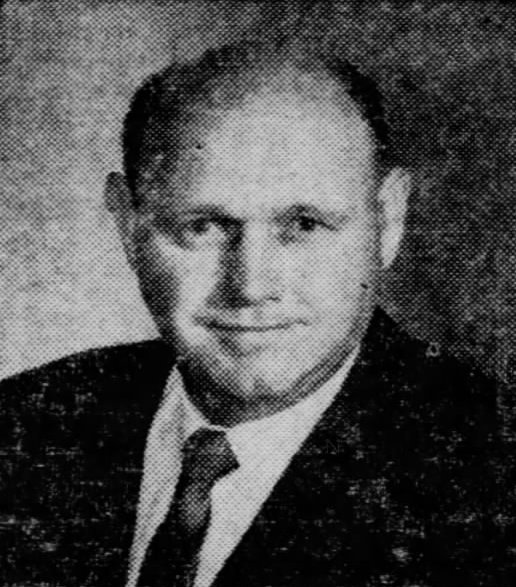
Born March 6, 1907 in Monrovia, Los Angeles Co., CA, died August 28, 2003 in Rancho Mirage, Riverside Co., CA. President, California Fraternal Order of Eagles, 1955. Life member, Benevolent and Protective Order of Elks. President, Orchid Digest Corporation, 1964, 1965. Sometimes known to SCOS members as "Mr. Greenhouse".
(Los Angeles Times, September 3, 2003) [We have added some additional information from other sources.] Obituary: Bowman, Charles E. "Charlie" Born in Monrovia, a second generation Southern Californian, he lettered in varsity basketball, track, and football at Monrovia High School, studied civil engineering at U.S.C., and in 1924 married his high school sweetheart Esther A. Laughlin (deceased in 1993). From that union a son Del, of Monrovia, daughter-in-law Nancy J. Bowman of Illinois; grandsons Greg of Los Angeles, Norm Bowman, California, Scott and Dana of Long Beach, CA; great-granddaughter Nicole of Medford, OR; sisters Margaret, Marjorie, Elizabeth, and Betty, brothers Albert and Louis, were all born in Monrovia.
A 64 year Long Beach resident, Charlie joined the Southern Calif. Greenhouse Co. [(on Rosemead Boulevard in El Monte, CA)] in 1950 as Sales Manager and eventually assumed partial ownership, retiring in 1986. [The company formed a separate entity for sales, California Greenhouse Controls Corporation, about 1979 at the same address. In 1989, California Greenhouse Controls became part of International Greenhouse Systems, Inc., and was active at least as late as 1992. What's at that address now? A mattress store!] He enjoyed family, friends, neighbors and especially those engaged in plant growth and orchid plant cultivation. He served as president of the South Coast Orchid Society in 1958, 1959 and 1969, also active in the Calif. Nurserymen's Assoc. and Living Plant Growers Assoc. Other affiliations included the Fraternal Order of Eagles (former State President) and Life Member B.P.O.E. In later years he traveled extensively with special friend Ann Wilson [(widow of former SCOS president and long-time judge Woodrow C. "Woody" Wilson)] to exotic botanical gardens and orchid collections across the U.S., Canada, and Hawaii. Both were active in Orchid Societies, particularly the endowment and publishing of the Orchid Digest Magazine. His request was that memorial contributions be made to the Fordyce Marsh Endowment Fund in care of Orchid Digest, P.O. Box 10360, Canoga Park, CA 91309. Private services were held at his request. Douglass Mortuary-El Segundo.
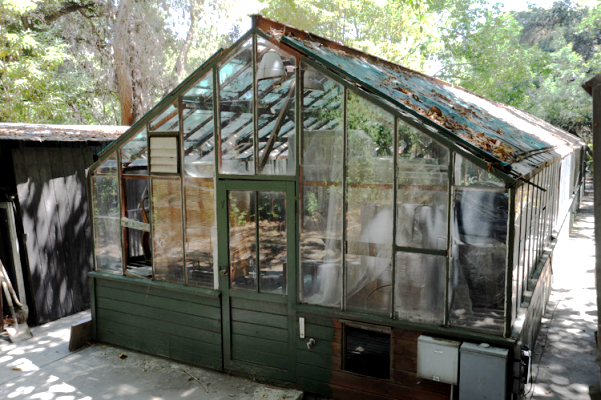
Greenhouse built by Southern California Greenhouse Manufacturers, photographed at the Raymond Burr estate in 2014
In the early days of SCOS, celebrities and the wealthy liked to give their estates in Beverly Hills and Hollywood the trappings of the English aristocracy, including greenhouses. Most of these people were not actually interested in horticulture, with some notable exceptions such as Samuel Mosher, Arthur Freed, and Raymond Burr. SCOS President John Reyes remembers stories that our "Mr. Greenhouse", Charlie Bowman told at dinner. Charlie Bowman (Southern California Greenhouse Manufacturers, Inc.) built most of the greenhouses in SoCal which included a long list of wealthy clients. He was called to Rupert Murdoch's estate in Beverly Hills (formerly built and owned by Tyrone Power). The estate had a proper English Head Gardener with the tweed jacket and hat who supervised everything and was well liked by all the staff. On the property was a several hundred year old majestic California live oak tree. Murdoch, in the presence of Charlie and all the staff, told the Head Gardener that he wanted him to cut the tree down. The Head Gardener explained this was a beautiful old tree and he should reconsider if he wanted to cut it down. Murdoch replied, "You are fired, pick up your belongings and leave the property today." (Nice guy, eh?) He said everyone was stunned. Charlie's opinion of Murdoch was beyond low. On the other hand, when the Dodgers moved to the west coast (1958), Dodgers owner Walter O'Malley had Charlie build him a greenhouse. Charlie said Walter was a perfect gentleman. We know of only one greenhouse built by Southern California Greenhouse Manufacturers that survived long enough to be captured in a modern photograph, on the old Raymond Burr estate.
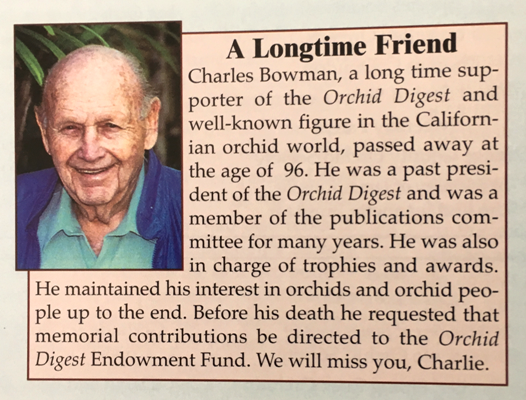
From Orchid Digest, vol. 67 (November-December, 2003)
Charlie often brought equipment from Southern California Greenhouse Manufacturers to add to the SCOS raffle table. Various fans, motors, min-max thermometers, and other gear are mentioned in the old newsletters. However, he wasn't the only greenhouse builder in our group. In December, 1954, on the occasion of the first official Orchid Digest judging session at SCOS, Mrs. and Mrs. Henry Fricker raffled off a greenhouse from their company, Fricker Orchids! The lucky winner was Mrs. Virginia Dickenson of Long Beach.
1960, 1961: Woodrow ("Woody") C. Wilson, 1918-1992
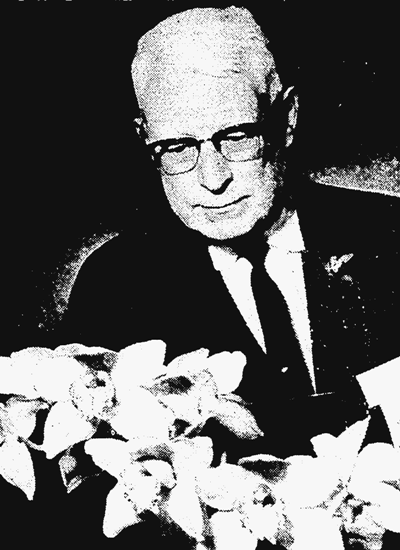
Woody Wilson judging Cymbidiums at the 1968 San Diego Orchid Show
Woodrow Carter ("Woody") Wilson was born in Birmingham, Alabama November 11, 1918, and died in Downey, Los Angeles Co., California December 19, 1992. Woody and his wife Ann Elizabeth (Hughes) Wilson came to Los Angeles County about 1951. They lived in Huntington Park in the 1960's and then on Melva St. in Downey from at least 1973 until his death. Ann was still at the same address until she moved to Pomona in 2003. Woody served in the military 1940-1968, retiring as a Major in the US Army Reserves after active service during World War II. He worked for the Internal Revenue Service as an Agent. Woody served in many capacities in SCOS, including at least Treasurer and President, and then he got interested in judging. He worked his way up through Associate Judge to Accredited Judge, and made the transition (at the beginning of 1968) from Orchid Digest judging to American Orchid Society judging along the way. His obituary in the Los Angeles Times suggested donations to the Cymbidium Society of America Computer Fund. After Woody's death, Ann continued her membership in SCOS until at least 2012. She was still on our mailing list as late as 2015.
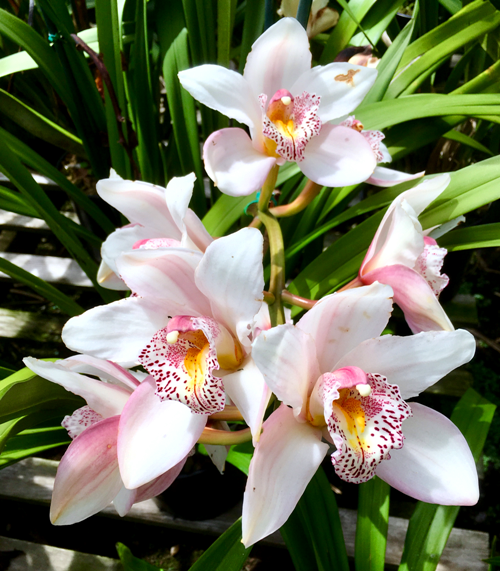
Cym. Woody Wilson 'Ann' AM/AOS SM/CSA, growing at Casa de las Orquideas in May, 2019
Eponymous orchids: Cymbidium Woody Wilson 'Ann' (Loren's Treasure × Solana Beach, hybridizer Loren Batchman of Casa de las Orquideas). Woody was a tall, imposing man who took judging very seriously and wasn't shy about expressing his opinions. He seems to have developed a rather fearsome reputation. His opinions (about the orchid flowers), according to the Batchmans, were well founded and largely respected. However, when Loren Batchman presented his new hybrid Cymbidium Woody Wilson 'Ann' for judging (that would have been around 1993), he found that some of the judges were reluctant to deal with anything named "Woody Wilson"! Nevertheless, this cross, Cym. Loren's Treasure x Solana Beach, produced some great plants. Loren thought it was the right one to name after Woody: a white Cymbidium for a guy with a stunning head of white hair. The clone 'Ann' is named after Woody's wife, who was also a member of SCOS. Nancy Batchman told us this plant is hard to exhibit, because the flower spikes want to droop, and the plant itself is much too big to grow safely in a hanging basket. But it's gorgeous!
1962: George McKee Hudson, Jr., 1906-1990
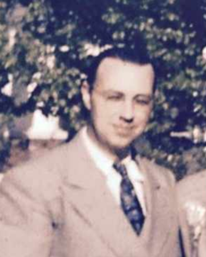
Born October 2, 1906 in Starbuck, Columbia Co., WA, died June 9, 1990 in Tacoma, Pierce Co., WA. Married Donna Pratt in Alameda Co., CA in 1926. He was a partner in the Rheinfrank & Hudson firm, a horticultural supply company, in Los Angeles. How do we know? Many people who were active in Southern California orchid societies were members of more than one club. The meeting dates were staggered through the month, so that your prize flower could always be shown at some orchid society meeting, no matter when it bloomed. We discovered membership rosters for the Orchid Society of Southern California (the one that now meets in Burbank) from 1957 and 1958. Both George M. Hudson (wife Donna, 159 W. 165th St., Gardena) and Karl F. Rheinfrank (5414 Sierra Vista Ave., Los Angeles) were OSSC members in 1957. We found advertisements from Rheinfrank & Hudson, or Rheinfrank & Associates, in local orchid newsletters and Orchid Digest over many years, and there is a least one publication from the Rheinfrank firm in a collection of nursery catalogues at the UCLA Library (Special Collections Department, not yet examined). From the advertisements, we know that Rheinfrank & Hudson sold all sorts of supplies that were useful to orchid growers, such as tree fern blocks, polyethylene sheeting, greenhouse equipment, etc. Karl Francis Rheinfrank was born in Minnesota in 1919 and died in Los Angeles in 1971. The firm frequently donated items to SCOS for raffles and door prizes.
1963, 1964: Paul Isaak Brecht, 1919-2007
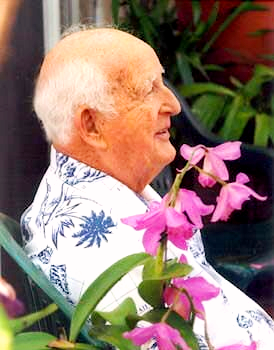
Born March 22, 1919 in North Dakota, died April 7, 2007. He was a founding member and first President of Newport Harbor Orchid Society, in 1979 and 1980. After working for Rod McLellan & Co. for some years, he established his own business, Paul Brecht Orchid Co., in Costa Mesa in 1962, also known as Brecht Orchid Garden or Gardens, where he offered an orchid boarding service that attracted a number of celebrities who lived in the area, such as John Wayne. The business was eventually converted to a parking lot, the ultimate, archetypal indignity suffered by so many remnants of Southern California history, in 2000.
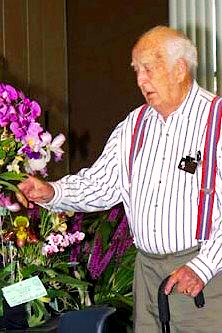
(Orange County Register, April 11, 2007) Brecht, Paul, a long time resident of Orange County, passed away on April 7, 2007 at age 88. He was born in North Dakota on March 22, 1919. In 1962, he founded Brecht Orchid Gardens in Costa Mesa. He was well known for his extensive community service. He is survived by his wife of 60 years, Jane, and their two daughters and six grandchildren. There will be a Memorial Service at 12 noon on Saturday, April 14th at Pacific View Memorial Park. In lieu of flowers, the family would appreciate donations in memory of Paul to St. Joseph's Hospital Foundation.
From the web site of Dakota College of Bottineau, in Bottineau, North Dakota: "In 1986, at the College’s 80th Anniversary Celebration, Paul Brecht was honored with a “Golden Service” Alumni Award in recognition of his achievements in the field of horticulture and his service to his community. Both Paul and his wife Jane believed strongly in giving back to their community and they gave generously of their time, talents, and funds for the benefit of others. Helping young students have an opportunity to get a college education was of special importance to them. And, as a result, they chose to endow the original Floriculture Scholarship at Dakota College. The Fund was originally established on June 20th, 1986, with an initial contribution of $2,000. Over the years, many friends and family members have continued to donate to the Fund. Upon the death of both Paul (in 2007) and Jane (in 2014), their daughters requested that the Fund be renamed in their honor as the Paul & Jane Brecht Scholarship Fund."
Paul Brecht, quoted in Orange Coast Magazine, April, 1992: After 50 years of researching and growing orchids, what’s my greatest accomplishment? That would be a botanical garden somewhere in Orange County devoted to orchids and tropical flora—and I’m still waiting! I have the collection—almost 10,000 plants and close to 8,000 horticultural books—but no place to go with it.
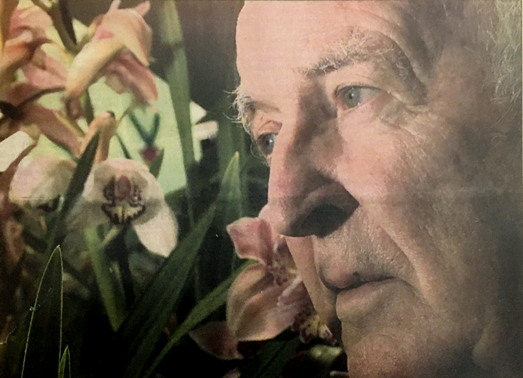
© 2002 Daily Pilot
"For nearly 40 years, Paul Brecht and his Orchid Garden have been fixtures on Newport Boulevard in Costa Mesa." Illustration from the Daily Pilot article about the closure of Paul's nursery. Lynn Wiand saved the newspaper clipping, or we would never have found this picture!
(Daily Pilot, January 15, 2000) Final bloom Andrew Glazer — Next month, contractors will knock down his little piece of paradise and build a parking lot in its place.
Bulldozers will level the shacks where orchid owners left their white, fiery orange and fuchsia flowers with Paul Brecht — owner of Paul Brecht Orchid Garden on Harbor Boulevard — to water, feed and baby-sit until they bloomed.
"People around here want instant color," said Brecht, 80, whose eyes are the same blue-green color as leaves on a Hawaiian Peach Delight orchid. "They don't have room for a flowerless green plant on their windowsill." Brecht, who has sold flowers on Harbor Boulevard for nearly 40 years, said it's finally time to close shop. And by Feb. 15, Brecht's business will be no more. "I'm looking forward to enjoying life," he said. "I almost waited too long."
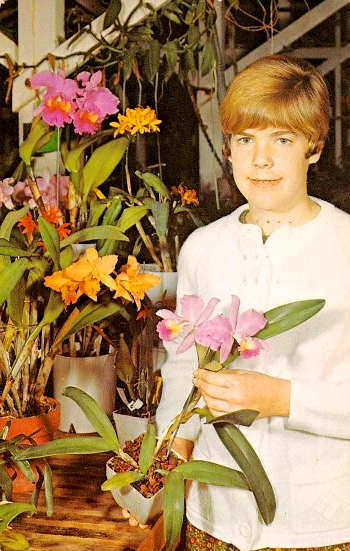
Advertising postcard from Brecht Orchid Co., 1989 Harbor Blvd., Costa Mesa, CA, postmarked in 1970. Stu Bance, son of SCOS members Leo and Terry Bance, worked for Paul Brecht for a year and identified the spokesmodel for us — she is Molly Brecht, Paul's daughter. The orchid she is holding is likely Lc. Bit-o-Blue, mentioned on the back of the postcard ("introducing one of our newest hybrids..."). However, the plant seems never to have been registered, at least under this name.
His wife Jane recently suffered from a series of strokes. And he is feeling pangs of arthritis in his sinewy fingers.
Galaxy Rent-A-Car will open its first Orange County location on the land in early March. Nat Panah, who owns a Galaxy branch in Westwood, said he will convert the main greenhouse — where Brecht displayed more than 1,000 orchids that were for sale — into the rental car store's offices. His son, Arash Panah, will run the new Costa Mesa store.
Brecht said he tried to find another plant store to lease the land from him, but had no luck. "The property's just too valuable," he said.
The car lot will replace one of the few businesses with deep roots on Harbor Boulevard — which was just a two-lane road when Brecht first opened his store there.
"That's progress, I guess," said Evelyn Hart, the former Newport Beach mayor who until recently left her orchid collection in Brecht's care. The store's charming organic disarray — with a flower garden and 12-foot totem pole in front — drastically conflict with the orderly right angles, hard concrete, chrome and glass that dominate the neighborhood. A 15-foot Jacaranda tree fans its branches in front of the store on Harbor Boulevard. It grew from seeds Brecht planted more than 30 years ago. A Mexican artist, who painted Brecht's orchids on her canvases, brought the seeds wrapped in a white handkerchief from Mexico City.
Brecht asked Galaxy to keep the tree and totem pole on the property. Panah said he would honor his wishes. "We're not cutting down any trees or that statue, whatever it is," he said.
Hart said there would be a void once the garden closed. "The neighborhood will lose character," she said. "You lose personality with the big chain stores. They're very convenient, but people don't know you."
"You can call Paul and say 'I've got a problem. What should I do?"' added Arlene Schafer, another former mayor, but of Costa Mesa. "If you call up one of the new huge stores, they'll say 'Can you hold?' Everything's automated."
Brecht said he won't let his passion for the flowers wilt in retirement. He'll continue taking care of his at-home orchid collection, which numbers in the thousands. And he'll remain an active member of the Newport Harbor Orchid Society, which he founded. Brecht will start selling his orchids at half price on Feb. 2. Ever the businessman, he explained why people should buy planted orchids for Valentine's Day.
"How much do bouquets cost? Twenty dollars?" he asked. "After three days, you throw them in the trash. Planted orchids cost just a little more, but last much longer."
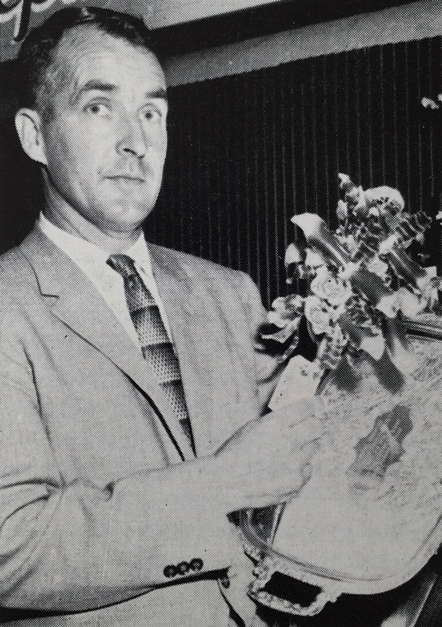
© 1958 Orchid Digest Corporation
Paul Brecht and Rod McLellan Co. won best in show for their Odontoglossum grande 'Dallas' at the 1957 Greater North Texas Orchid Society show. What nostaglia! In those days we had real Odontoglossums. These days, after an intervention by the Royal Horticultural Society, they're just Oncidiums.
The transformation of historical buildings into parking lots is so deeply ingrained in the California story, it has become a cliché! Let us try to ensure that something of our history will escape being paved over!
In fact, the story of the Newport Harbor Orchid Society and Paul's role in its founding turns out to involve more SoCal clichés—traffic and the freeways! (From the December, 2004 newsletter of Newport Harbor Orchid Society, reporting on recollections of Pat Rowland) "Would you believe that the oil shortage and rising gasoline prices of the late 1970's were a contributing factor in the founding of NHOS? At the time, cymbidium enthusiasts drove 40 minutes or more to the LA Arboretum to attend the monthly CSA meetings. It became Bud Rowland’s goal to establish a branch of the CSA in Orange County. In 1978 the first organizational meetings to launch the new society took place in Jane & Paul Brecht’s spacious second floor bonus room in their Irvine home. Besides Bud Rowland and the Brechts, other organizers included Howard Wilburn, Les & Millie Starkey, Alf Friend, and Woody Wilson. Rather than a branch of the CSA, the organizing group decide that NHOS would have a general orientation with a focus on growing orchids outdoors. By the end of the 1978, the society was ready to launch the general meetings so invitations were mailed to OC residents of the CSA and customers of Brecht’s Orchids inviting them to attend the “first informal meeting” at the Glendale Federal Savings Community Room in Fashion Island across from Buffum’s.
"To everyone’s amazement, a spillover crowd turned up for the first meeting on January 18, 1979 to hear Paul Gripp of the Santa Barbara Orchid Estate speak on “Outdoor Orchid Growing” and particularly laelias which were not yet well-known among OC hobbyists. Thereafter the meetings, with Paul Brecht’s help, were moved to the First Methodist Church on 19th Street in Costa Mesa. Among the first speakers were Clark Day on paphs, Bob Dugger of San Diego on odontoglossums, Lloyd de Garmo on cymbidiums, “Doc” Charles on paphs, P.G. Barnett on cattleyas, and George Vasquez on phalaenopsis. With a $100 contribution from Howard & Eve Wilburn to fund the speakers (a $25 honorarium for gas money) and mailings, in addition to the promise of 150 blooming plants from Pat Rowland for the plant raffles, the NHOS was launched."
Eponymous orchids: Oncidesa Brechts' Fiftieth (Rod McLellan & Co., 1996, on the occasion of Jane and Paul's 50th wedding anniversary).
1965, 1966: Lloyd DeGarmo, 1925-2010
Born May 6, 1925, died February 22, 2010 in Westminster, Orange Co., CA. He was Director of Libraries at Compton Community College 1962-1981. After his retirement, he lived in Hawaii. He donated his extensive library of orchid-related materials to the American Orchid Society. He received the AOS Achievement Award for contributions to orchidology March 19, 2005. Stu Bance, who worked for Lloyd for several years, remembers his extensive collection of miniature Cymbidiums, and Lloyd's mother Agnes, "Mama Dee".
(SCOS newsletter, April, 2010 — a similar notice was published by the Orchid Society of Southern California, where he was also a member) Lloyd DeGarmo — SCOS Past President 1965-1966, by Norito Hasegawa. Lloyd DeGarmo passed away on Feb. 22, 2010. He was 86. He served as an Orchid Digest Judge (no longer a judging system), a Cymbidium Society of America Judge, and an American Orchid Society Judge, becoming an Emeritus Judge in the latter two judging systems which only very few judges ever attain in their lifetime! Lloyd was a retired librarian at the Compton Community College before retiring to Hawaii. An avid reader, he amassed a large orchid library which was eventually donated to the AOS. He was instrumental in editing the voluminous Proceedings of the Fifth World Orchid Conference held in Long Beach in 1966 sponsored by the Orchid Society of Southern California, introduced Cymbidium Peter Pan 'Greensleeves' when converted to a tetraploid, and became a very famous breeder of miniatures and novelties. Probably his most lasting fame will be the registration of the trigeneric Oncidium alliance hybrid genus Degarmoara in 1967, combining Brassia, Odontoglossom and Miltonia. SCOS can be proud to claim him as one of our own.
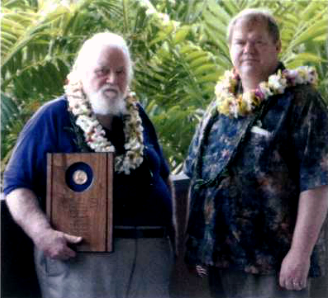
Lloyd DeGarmo receives the AOS Achievement Award from James Rassmann, Hilo, Hawaii, March 19, 2005
Lloyd received the AOS Achievement Award March 19, 2005, at the Hawaii Supplemental Judging Center in Hilo, Hawaii. The award was presented by James Rassmann, fellow AOS judge with his own distinguished record of service to AOS. The text of the presentation was published in Orchids later the same year:
To come to Hilo is always a pleasure. To come for the singularly special purpose of honoring my friend Lloyd DeGarmo is special indeed and I thank you all for the opportunity. It has been my pleasure to know Lloyd since I started in orchids 31 years ago, first casually as a member of the Orchid Society of Southern California and as a student judge, and later when we were AOS committee members and trustees. Lloyd’s kindness, sincerity and wise counsel have always been there for me as well as for the AOS. His many contributions to the orchid community are worthy of honor and praises and that is what we are here to do today.
Lloyd DeGarmo joined the American Orchid Society in 1946, a noteworthy year – principally because I was born in 1947. Lloyd has been a member for nearly 60 years. Few among us can claim that distinction. Can you imagine how many AOS Bulletins and Orchids magazines are stacked up in his garage? He should be lacking only 99 issues.
When Lloyd first joined the AOS he was a naval officer serving in fire control (fire control implies “a fireman” to some people. More accurately Lloyd was a “gunnery control” officer) on the USS Missouri in both World War II and the Korean War. He continued to serve as a naval reservist, eventually achieving the rank of Commander. As a civilian, Lloyd became the head Librarian at Compton College and was named Librarian Emeritus upon his retirement. He was also named Senator Emeritus for the Academic Senate of California Community Colleges.
His skills as a librarian have benefited the AOS through his passionate interests in the AOS library and in our history as a Society. He has served with distinction on many AOS committees and task forces including Library, Historical, Information, Judging, Nominating and as a two-term member of the Board of Trustees.
Lloyd is an emeritus judge of not only the AOS, but also of the Cymbidium Society of America, which he joined in 1953. As a judge, Lloyd’s ethics and deportment are above reproach and he is an example to all.
Lloyd’s interests in orchids have been concentrated principally in the genera Cymbidium and Oncidium. Among cymbidium enthusiasts, particularly hybridizers, Lloyd is forever linked with Cymbidium Peter Pan ‘Greensleeves’, HCC/AOS (ensifolium × Miretta), a clone he chose one day on a buying spree at Dos Pueblos Orchids. He is also known for the complex hybrid named in his honor, Degarmoara (Brassia × Miltonia × Odontoglossum).
Most importantly, Lloyd has been among the Society’s most effective ambassadors. As a member of not only the Orchid Society of Southern California, but also the San Gabriel Valley and Hilo Societies, his participation has furthered the goals and objectives of the AOS and shown those in local societies our best possible face. As a mainlander coming to the islands, he continued to be an ambassador extraordinaire by his willingness to take on challenges and his generous contribution of his time, effort and other resources. His acceptance here and the respect you bestow on him are more than ample proof of his value to our world of orchids.
Lloyd has always been a gentleman and someone of great value to the American Orchid Society and its members. It is with great pleasure that I present Lloyd DeGarmo with the American Orchid Society’s Achievement Award on behalf of the Board of Trustees who enthusiastically and unanimously bestow it in recognition of his outstanding contributions as an AOS ambassador.
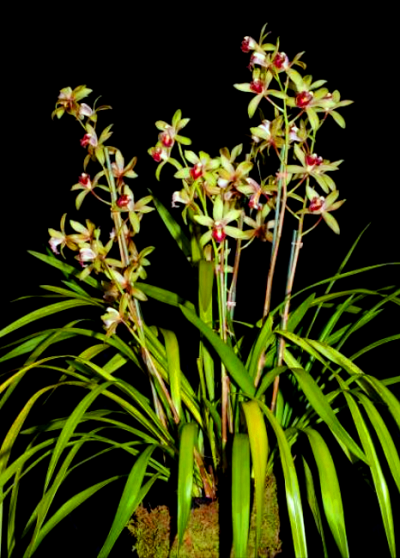
Cym. Peter Pan 'Greensleeves', a plant Lloyd DeGarmo purchased during a shopping trip to Dos Pueblos Orchids in Goleta
Degarmoara was a great idea, an important step in the development of the Oncidium alliance intergenerics, which are today extremely popular and found in grocery and home improvement stores. Unfortunately, the taxonomists had other ideas. First, Odontoglossum was split into about a dozen pieces; the most popular species ended up in new genera. Then, essentially all of what was left of Odontoglossum was lumped with Oncidium. Also, quite a few of the more interesting Oncidium species were split out into other genera. Alas, without any officially-recognized Odontoglossum species remaining, and many Oncidium now using other names, there cannot be any Degarmoara hybrids! The original Degarmoara Agnes, created by Lloyd and duly registered in 1967, was Brassia antherotes × Miltonidium Debutante (Miltonia warscewiczii × Odontoglossum carniferum). The new intergeneric hybrid was called Degarmoara Agnes, after Lloyd's mother. Brassia antherotes is now known as Brassia arcuigera, Miltonidium Debutante has turned into Oncidium Debutante, Miltonia warsewiczii has become Oncidium fuscatum, and Odontoglossum carniferum is now officially Oncidium carniferum. As a result, the original Degarmoara is now Brassidium Agnes.
Eponymous orchids: Cymbidium Lloyd DeGarmo (registered in 1970 by another SCOS member and nurseryman, Clark Day, Jr.), Cym. Agnes DeGarmo (named after his mother), and of course, the intergeneric Degarmoara created in his honor but now completely empty, as mentioned above. He is also noted for introducing the tetraploid cultivar Cym. Peter Pan 'Greensleeves'.
1967, 1968: Charles Virgil Stockham, 1914-1991

Courtesy of Long Beach Fireman’s Historical Photographs Collection, Gerth Archives & Special Collections, California State University, Dominguez Hills
Charles Stockham, official portrait, 1967
Born February 19, 1914 in Fargo, North Dakota (another source says 1915), died June 26, 1991 in Orange Co., California. He married Alice Katherine Price, from South Dakota, in 1939 at St. Luke's Episcopal Church in Long Beach. They had both lived in Long Beach since at least 1935. After their marriage, they lived on Cherry Ave., and Charles worked as an engineer in the aviation industry. Charles joined the Long Beach Fire Department in 1945, and attained the rank of Captain in 1966, retiring in 1974. Assigned to the Long Beach Fire Prevention Bureau (photographic portraits 1960 and 1967 in Long Beach Fireman's Historical Museum Photographs Collection, California State University, Dominguez Hills). As part of his role at the Fire Prevention Bureau, he was frequently consulted by the local press when questions arose about fire safety — including advice about how to fire-proof grass skirts imported from Fiji! A natural enough question, given the popularity of everything Polynesian at the time, including the annual SCOS luau and our charter tours to orchid nurseries in Hawaii!
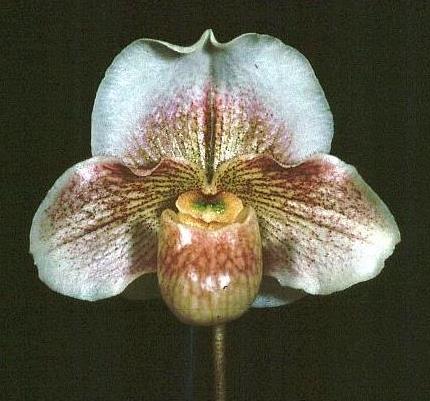
© 1981 AOS
Paph. Dusky Maiden 'Pocahantas' AM/AOS, exhibited by Charles Stockham November 23, 1981 at the Long Beach judging center.
Among the trophies awarded at the Fascination of Orchids shows, we spotted the "Charles V. Stockham Memorial Trophy" (for best specimen, any genus), awarded 1n 1998 to Pat and Ginny Worthington for Rhyncholaelia (=old Brassavola) glauca 'Donmary', and in 1999 to Edward Voelker for his Paph. philippinense 'Voelker's Pride'. We know that Stockham was interested in Paphs, for which he won at least half a dozen awards, including one for a plant originated and registered by John Hanes, Paph. Dusky Maiden. Another, in 1977, was an HCC/AOS for his Paph. fairrieanum 'Stockham', at the Long Beach judging center, for which there does not seem to be a photo.
More of his career can be gleaned from an obituary notice published in the Orchid Advocate (newsletter of the Cymbidium Society of America) 17(5):178 (September, 1991), written by SCOS's own Ann Wilson, wife of "Woody" Wilson:
Charles Stockham (1914-1991)
We are sad to report that Charles V. "Chuck" Stockham of Long Beach, California, passed away on June 26, 1991 at the age of 77. He was a Cymbidium Society of America member for twenty-two years and was active in the CSA judging system. Chuck was elevated to Senior Judge status one year ago and had previously served as Chairman of the Orange County Branch judging.
Chuck was born February 19, 1914 in Fargo, North Dakota and moved to Long Beach in 1920. He attended both UCLA and USC, and was employed by the Long Beach fire Department for thirty years, retiring as a Captain. In addition to being an accomplished cymbidium hobbyist, he was an avid hiker and a member of the Sierra Club.
Chuck's wife of 49 years, Katherine, passed away a few years ago. He is survived by one son, John and daughter-in-law, Diane. He will be greatly missed by his many Cymbidium Society friends and associates.
Ann Wilson
1969: Charles E. Bowman, see above
1970, 1971: Dr. Charles Joseph Aucreman, 1912-1980

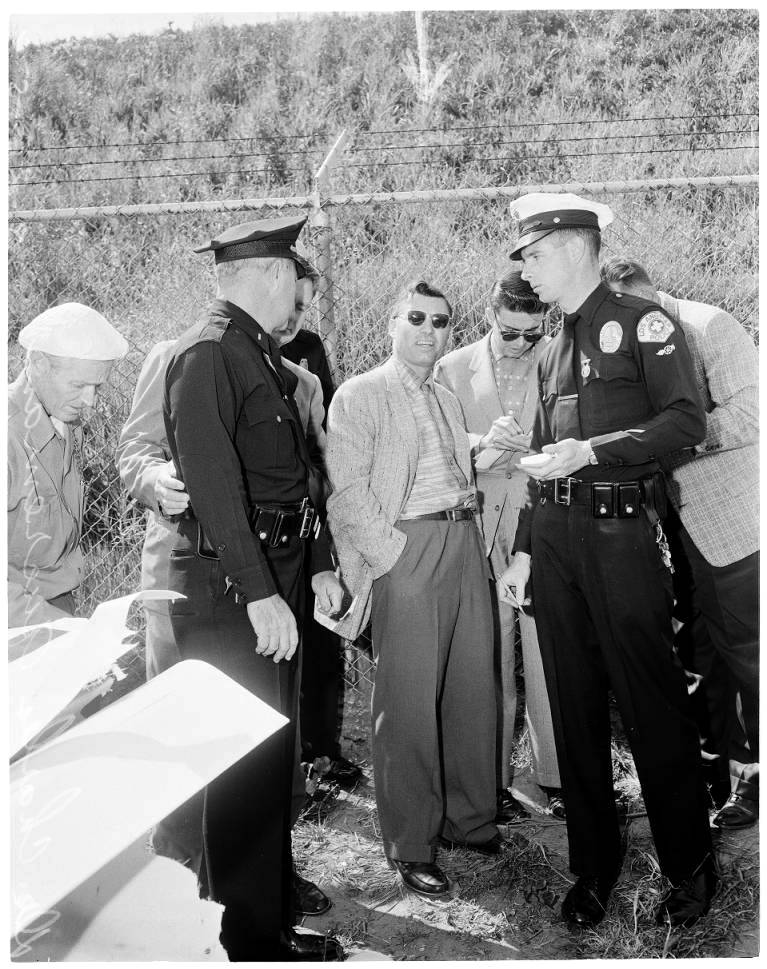
© 1959 Los Angeles Examiner
Dr. Charles Aucreman (facing the camera, sunglasses) talks to police and reporters after his airplane came down on Bundy Drive, March 26, 1959. Could have been a scene right out of Dragnet.
Born December 16, 1912 in Indiana, died March 17, 1980. US Army Air Corps, M.D. After World War II, he and his wife Marcella (1917-1986) lived in Indiana, where he had an optometry practice, at least until the mid-1950's. After they moved to California, he worked as an oculist in Inglewood. His son, also named Charles, became a physician as well, specializing in radiology.
The elder Dr. Aucreman had some aviation adventures, including a near miss in March, 1959, when he was flying with a friend back from an excursion to Bakersfield. Their Mooney Mark 20A ran out of fuel over the Santa Monica mountains, short of their destination, the Hawthorne airport. Aucreman diverted to the Santa Monica airport, but was unable to align the flight path properly for landing before losing altitude. The plane went down on top of a car on Bundy Drive. No one but the airplane and the car was hurt; the fuel gauge at the time indicated the tank was still 1/4 full. Photos from the files of the Los Angeles Examiner (USC Digital Library, "Dick" Whittington Photography Collection) included the only picture of Dr. Aucreman that we have been able to locate.

© 1959 Los Angeles Examiner
Update: Finally, May 2, 2025, we spotted another photo of Dr. Aucreman, taken at the 1973-1974 awards banquet of the Cymbidium Society of America, in June, 1974.
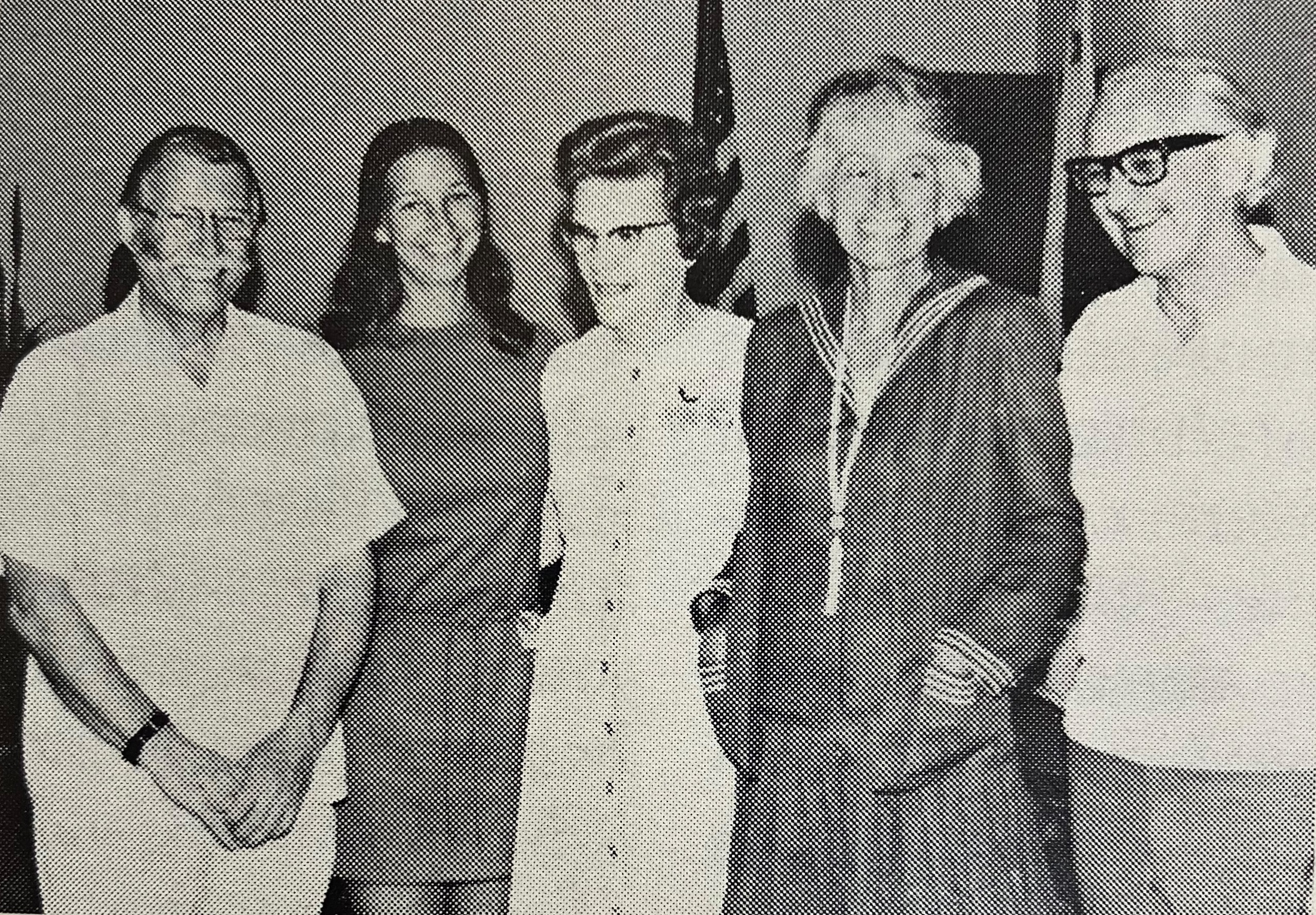
© 1974 CSA
Photo from 1973-1974 CSA awards banquet: (Left to right) Dr. Aucreman, Program Chairman; Mrs. Slattery, Secretary; Mrs. Zeramby, Membership Secretary; Mrs. Lawson, Treasurer; Mr. Starkey, President (Cymbidium Society News 29(4) (July-August, 1974)
1972, 1973: Dr. A. G. Tharp, 1927-2011

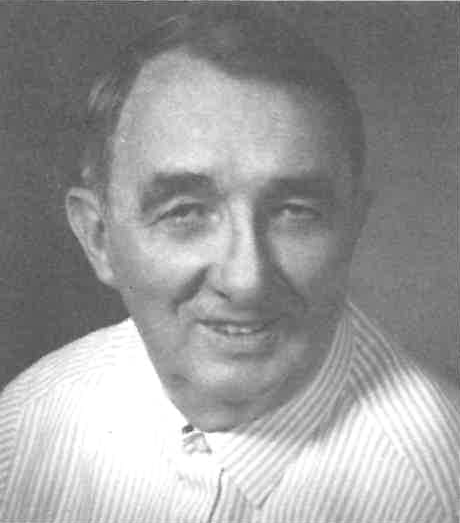
Born in Kentucky January 6, 1927, died in Lakewood, Los Angeles Co., CA in 2011. His initials apparently did not stand for anything else (he listed his full name as A. G. Tharp on his World War II draft registration card, for example). He had a long career as a chemist and university professor, specializing in the properties of the rare earth elements. As an orchid judge, he was another of those fearsome characters who had very strong opinions about orchids, but he left us a clear account of why he was reluctant to award every pretty flower that came along (see below).
(Californa State University at Long Beach, Chemistry and Biochemistry Department newsletter, Fall, 2011.) A.G. Tharp 1927-2011, By Drs. H.N. Po and N.M. Senozan. Dr. A.G. Tharp, who taught in our department from 1959 to 1987, passed away in his Lakewood, Calif., home on June 20. He was 84 years old.
For 28 years, A.G. almost always taught one of the two lecture sections of the second half of general chemistry, known originally as CHEM 1B and later as CHEM 111B. He also taught advanced inorganic courses, served as graduate advisor and conducted research on rare-earth elements, including ytterbium, samarium and holmium. This research led to a total of 13 publications in leading chemistry journals. It is not an exaggeration to say that our department's tradition of excellence in inorganic chemistry can be traced to Dr. Tharp.
A.G.'s stoic demeanor sometimes masked an affectionate and generous person who had a deep appreciation of natural beauty. His passion for orchids reflected this appreciation. On the roof of Peterson Hall III, now replaced by the Hall of Science, he tended an orchid garden resplendent in color and form. His extensive knowledge of orchids landed him a position as an orchid judge in the Southern California section of the American Orchid Society, and later, recognition as a Distinguished Emeritus Orchid Judge.
After retiring in 1987, A.G. went to the Philippines and ventured into the orchid growing business with a Filipino grower. The tropical climate and the cheap labor helped the business thrive for some 10 years. Then, salt water seeped unexpectedly into the artesian wells, and the business went downhill. Dr. Tharp returned to California not a bitter man but happy that he had 10 great years to do what he loved.
Dr. Tharp's deliberate, slow cadence in speech and motion hid another surprising skill from a casual observer. He was an avid flyer, who often treated his students and colleagues to the unforgettable thrills of flying in his small plane.
At times, A.G. could be quite quirky, and his charm, in part, rested on his idiosyncrasies. One that we remember well was his revulsion to any mention of the Henderson-Hasselbalch equation or any use of this equation by a student on an exam. He apparently could not accept that a simple rearrangement of the equilibrium constant expression would immortalize these two names.
Dr. Tharp is survived by a sister and her family in Kentucky.
(Awards Quarterly, 1993, 77-78.) The Philosophy of Judging, By A. G. Tharp, PhD.
The Handbook on Judging and Exhibition recommends that the "The Philosophy of Judging" be incorporated into all training programs for American Orchid Society judges. There does not seem to be a source that enunciates or suggests what aspect of philosophy should be taught or espoused and it is expected that one would not get a very uniform view from the present judges as to what philosophy or what aspect of philosophy is applicable to judging flowers. The views might well range from procedures and policies to be utilized to a much more academic definition. I once heard philosophy defined as "the search for the truth." This would seem to be an applicable concept where judging orchids is concerned because the central question is what award does the plant warrant, if any. Certainly, such aspects of philosophy as ethics and logic are germane to making judgments that are factual and supportable. Following is my perception of some factors that a judge must possess or know before making factual judgments.
Central to our philosophy must be the reason that a judging system even exists. The Handbook on Judging and Exhibition answers this question fairly competently when it states something to the effect that the purpose of the judging system is to encourage people in all phases of orchidology. Another way of stating this is that if judging orchids is to severe a useful purpose, then granting recognition to plants and to people associated therewith, should encourage people to further all facets of endeavors associated with orchids. Is it not equally important to preserve those plants that produce rather innocuous flowers as it is to preserve those species that produce the generally accepted truly beautiful flowers? The answer is obvious. The entire range of possibilities must be covered. Central to the issue of having judges who are truly qualified to make factual judgments are the qualities absolutely essential for the prospective judge to possess, as well as the knowledge already gleaned or that can be gained.
Any prospective or current certified American Orchid Society judge must have an aesthetic faculty if he or she is to be a qualified judge. Obviously, if one cannot recognize actual beauty, one doesn't possess the most fundamental quality necessary to be a judge. Assuming this observation is true, and it seems obvious that it must be, then those persons passing judgment on another person are faced with an awesome dilemma.
How does one determine the degree to which another possesses a purely subjective quality? This is especially awesome when it is relative to people involved with the orchid family since the diversity of color, form, size, etc., is so large. About the only way one can deal with this important aspect is to utilize the consensus of opinion of a group of people who are presumed to be able to recognize actual beauty, or the lack thereof, when they see it. Everyone who must make these judgments is placed in a tenuous position because they are faced with making a decision that is based upon a presumption that may not be fact. It is suspected that very few people possess an aesthetic faculty to the degree that is desirable to function as an exceptionally competent judge. Clearly this area is a very argumentative one, with no finitely correct statements that can be made — and proved to be correct. Nevertheless, one should be aware that it exists, and we should increase efforts to be more cognizant of its existence when selecting new judges.
Ideally, every judge should be free of bias and prejudice. Unfortunately, this is never the case. Bias and prejudice come in all forms and with respect to all things. If we are to make competent judgments, everything must be done to eliminate beliefs and ideas that are detrimental to ascertaining the facts. Everyone should be able to recognize, and to some degree, be able to control their biases and prejudices. The fact remains, however, that some people prefer certain colors, sizes and forms, etc., over others, encompassing the entire gamut of diversities found in orchids. How does one deal with these human qualities? One simple answer is for an individual to disqualify himself or herself when he or she is aware of specific prejudices. If one doesn't find a particular genus, e.g. Paphiopedilum, to be appealing, the obvious thing is to not make judgments on plants within this genus. Another, somewhat more difficult-to-achieve-method of dealing with bias and prejudices is for the chairman of judging to refrain from assigning a plant to be judged to be one or more individuals who might not find some fundamental aspect of the flower to be appealing regardless of its qualities. If one dissects this phenomenon to the most finite degree, the logical conclusion is that judges should be certified to judge only certain genera. The fault with this line of thinking is that there are certain persons who have no particular prejudices or favorites, equally qualified to judge all genera with their almost infinite variations. They could be classed as some type of master judge. The prudent individual is bound to reject this latter line of reasoning because it is inherently unwise to have a caste system in something as restricted as our judging system. Probably a caste system is unhealthy in all circumstances, but this line of argument is not relevant to this discussion. What is relevant is that bias and prejudice exist and they must be dealt with or the truth will not be achieved.
A very important human trait that influences whether or not one can reach a valid and supportable truth is attitude and emotion. How many people can really remain coldly objective at all times? Are there not some who would let their emotions unduly influence their judgment if they viewed for the first time a flower that, to them, was new and of unsurpassed beauty? Conversely, would there not be some who would view rather negatively a flower that really deserved recognition for the elementary reason that they had seen similar flowers over a long period of time and had thus become too familiar with genus, color, size or type of flower? Although it overlaps another facet of reaching valid judgments, a good example that is presently occurring can be cited. How many judges had viewed a reasonable population of Paphiopedilum armeniacum when a FCC/AOS was awarded to the first one that had been presented for judging? Since this occurred in this writer's region, he knows that all were viewing this species for the first time. Considering, the subsequent equivalent awards to this species, it is not unreasonable to assume that it was the first paphiopedilum the judges had seen that possessed a yellow flower, and this fact generated undue influence. Because yellow is a generally pleasing color, could this fact have led to a rather emotional conclusion?
Another similar example is the recent awards to the red-flowered Phragmipedilum besseae. The intent here is not to say that attitude and emotion are irrelevant to making supportable judgments. After all, isn't it an emotional as well as sensual experience to view anything that one perceives as beautiful? One should simply be aware of the need to exercise reasonable control and not be "carried away." In short, one needs to see a representative population of a species or grex before any valid judgment can be made.
Associated with the preceding discussion is the phenomenon of judging one's own plants, plants owned by one's employer, etc. The Handbook on Judging and Exhibition, for good and just reasons, prohibits a judge from judging a plant with which they obviously have some close connection. This is allied with judging plants whose owners are known to the judges. Can a judge arrive at a supportable award for a plant belonging to an individual that is personally distasteful to the judge? This would lead to a lengthy dissertation because some judges would be influenced and others would be objective. Hopefully, most would be objective since the owner of the plant is totally irrelevant to the quality of the plant. It should be remembered that when a plant is presented for judging, the only thing that matters is what award, if any, the plant should receive.
Probably a not-too-frequently-considered fact is that attitudes can be created. Consider a person walking into the judging area making a comment to the effect that the plants available for judging are a rather sorry-looking group of junk. Despite the fact that all judges should be able to make independent judgments based upon their own knowledge, perceptions and experience, it is a fact that people are influenced by the conduct of others — some positively, others negatively. Discussion or comments within a judging area, as well as during the judging process, should be limited to factually, finite statements, both positive and negative, based upon one's own knowledge and expertise. Further, everyone should remain cognizant of the presumption that other certified judges are qualified, and extraneous opinions are not needed unless elicited.
Central to arriving at a consensus that is at least nearly factually correct is that those people making the judgment must possess a vast amount of knowledge. It is impossible for any one person to possess enough knowledge to be truly competent with all species and hybrids. However, a certain amount of knowledge is absolutely essential. Every judge should have sufficient knowledge to know that if presented with a full-formed, large, dark purple flower, labeled (C. araguaiensis × C. iricolor), the chances are negligible that it is correctly labeled. One just cannot evaluate something without knowing something — actually, a lot — about its origins. Thus, it is clear that one must know the species and also have a broad knowledge of the hybrids. It is clear and not argumentative that to be a competent judge, one must be a devout student of orchidology.
A good example to illustrate the point is that in recent years a number of awards have been granted to Vanda coerulea. A few have been FCCs and several highly scored AMs. Now ask yourself, who knows V. coerulea the best — Thais or Americans? How many FCCs have the Thais and Americans awarded? How many FCCs have the Thais given to this V. coerulea? Remember, they have seen thousands. American Orchid Society judges have granted awards to plants of this species that are so ordinary they would be sold for a few baht in Thailand. To compound the errors, several of the plants awarded are not even V. coerulea. The errors made are so contrary to the facts that it is obvious something has failed.
Obviously, everyone cannot visit every nursery regularly, even in their own country, but everyone can read books, study magazine, view slides and photographs, study catalogs, visit many nurseries and collections and maintain such activities with a view to learning so their knowledge will be greatly enhanced. Any judge who does not do these things cannot possibly keep current and thus, judgments will frequently be flawed.
In summary, a competent judge must be objective, remain coolly unemotional within limits, be ethical, possess vast knowledge, have no aberrations in vision that aren't corrected, and probably several other traits. It is not an easy task to be a competent judge; one must continually strive to keep abreast in these fast-moving days in orchidology.
Dr. Tharp encountered several of our members and friends during their college years. Norito Hasegawa and Norman Fang were in his chemistry classes, where they had to put in long hours in the lab next to Dr. Tharp's office — probably the reason they are not chemists today! Norman remembers a big display case in the hallway next to Dr. Tharp's office, filled with orchids. Until much later, he had no idea that the orchids were in any way connected with Dr. Tharp. When they later encountered each other at an AOS judging center, confusion ensued: (Tharp:) "What are you doing here?" (Norman:) "I'm looking for the orchid judging center. What are you doing here?" (Tharp:) "I'm the orchid judge."
Norman remembered something else about Dr. Tharp's chemistry class: The professor would walk into the lecture hall on some mornings and stand motionless for a long time before speaking; the students could barely breath, fearing that he was about to berate them for something. It was only after learning about orchid judging that Norman put the pieces together: Dr. Tharp had been up late at SCOS meetings on certain Monday nights judging orchids, and so on the following Tuesday mornings, he was still tired and had trouble starting his lectures! Dr. Tharp also served as orchid judging mentor to Peter Lin, now chair of the AOS Pacific South supplementary judging center that shares our meeting place, and past President of Orchid Digest Corporation. Dr. Tharp was a "student judge" in the early 1970's at the same time as SCOS member Norito Hasegawa.
We understand Dr. Tharp may have worked with Andres Golamco Jr. in the Philippines. Both men were involved in the publication of the new species Phalaenopsis philippinensis (See Orchid Digest 51:92, 1987.)
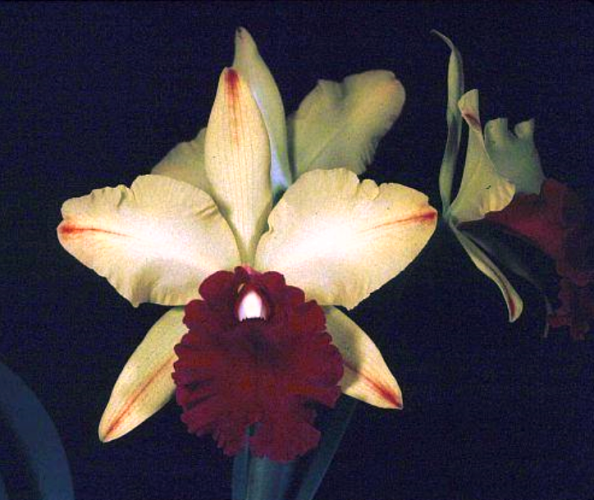
Rlc. Toshie Aoki 'Miniflares' AM/AOS, exhibited by Dr. A. G. Tharp at the Long Beach judging center July 27, 1981, during the regular SCOS meeting
Eponymous orchids: Dr. Tharp, as far as we know, did not hybridize orchids, but his name is found as "registrant" for a number of popular hybrids. Among these are the highly awarded Rlc. Waikiki Gold and Rlc. Toshie Aoki, which were created by the famous Hawaiian orchidist Masatoshi Miyamoto, said to be "a superb orchid grower but a poor correspondent" — so averse to writing letters, we understand, that collectors learned to contact him by long-distance telephone calls. Somewhere along the way, Dr. Tharp must have called Mr. Miyamoto (or perhaps met him at some point) and volunteered to take care of registering some of his hybrids with the Royal Horticultural Society so that they could win the awards they deserved.
1974, 1975: Paul Gillette Shaub, 1910-1984
Born August 20, 1910 in Bell, Los Angeles Co., CA, died November 27, 1984 in Huntington Beach, Orange Co., CA. His wife Blanche was born July 4, 1907 in Wisconsin, died in Huntington Beach, Orange Co., CA in February, 1984. In the 1970's, along with several other SCOS wives, she was active in the Long Beach Auxiliary of the Southern California Symphony-Hollywood Bowl Association. Paul was superintendent at the Halco Manufacturing Co. in Los Angeles (precision aircraft parts, the original location is now in the City of Commerce, the company moved to a new plant in Monterey Park in 1957) in the late 1950's, according to Long Beach city directories. Before that, about 1954, he worked as a machinist at Precision Equipment Co. in Torrance. By 1968, he was working for Steel City Division, Midland Ross Corporation, in the City of Commerce, and in the early 1970's, for Arrowhead Brass Products, in Los Angeles (still in business today at the same location, as Arrowhead Brass).
1976, 1977, 1980: Arthur Thaddeaus McCann, 1913-2009
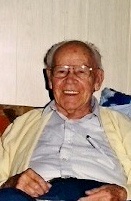
Art was born May 13, 1913 in Illinois, died about July 26, 2009 in Sacramento Co., CA. His wife Erma ("Billie"), born February 10, 1913, died December 26, 2001 in Huntington Beach. Art was one of the founding members of Newport Harbor Orchid Society in 1979. SCOS member Lynn Wiand, who was President of Newport Harbor Orchid Society, remembers, "Art and I were always good friends. When he was planning to move to Paradise to live with his caretaker I helped Art with selling his orchid memorabilia and book collection. I have a couple of photos I took of Art then. He was age 96 or so. I will look them up. I also had one of Art at Brecht’s Gardens which I will also see if I can locate. Art worked at Brecht’s Orchids in Costa Mesa for the entire time they were open until he retired. He was our NHOS Culture expert and led classes from 1979 until 1993 when it became too difficult for him to haul around all the supplies he needed for the classes."
1978, 1979: Dr. James H. Miller
After his tenure as President, Dr. Miller continued to serve SCOS in many capacities until about the end of 2006. He was especially handy in the kitchen during our December potluck parties, where he supervised the turkey. We asked several people about his title. The unanimous opinion is that he wasn't a medical doctor, but beyond that, no one seems to know.
1980: Art McCann, see above
1981, 1982: Jane Ewing Brecht, 1919-2014
Born Jane Ewing, August 22, 1919, in Santa Clara Co., CA, wife of Paul Brecht, also a past president of SCOS, died September 15, 2014 in Colorado.

Two snapshots featuring Jane Brecht, from the SCOS newsletter, at the holiday party in December, 2006
Orchids Aweigh, newsletter of the Newport Harbor Orchid Society, Costa Mesa, CA, September, 2014): — In Memoriam: Jane Brecht. It is with great sadness that we announce the passing of Jane Brecht in Colorado earlier this month. Jane was the wife of Paul Brecht, founding member and president of the NHOS. Up until a few years ago Jane was active in other area orchid societies and activities. In late March of this year she suffered a fall that resulted in cracked ribs and the compression fracture of a vertebrae. As a result, Jane spent a significant amount of time in hospitals and skilled nursing homes trying to recover from the fall, which took both a physical and mental toll on her. In August her daughters, Polly Juneau and Molly Polidoroff, moved their mother to Colorado, per her wishes. Jane passed away peacefully in her sleep on September 15. She was 95 at the time of her death. There will be no funeral, but rather a private family graveside service. Should you wish to remember Jane, donations can be made to the DCB Foundation for the Brecht Floriculture Scholarshio, c/o Dakota College at Bottineau, 105 Simrall Blvd., Bottineau, ND 58318. The Brechts established the fund in 1986 and over the years a number of students have benefitted from this financial assistance. Our sincerest condolences to Polly, Molly, and their family.
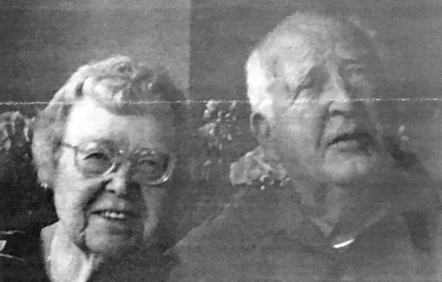
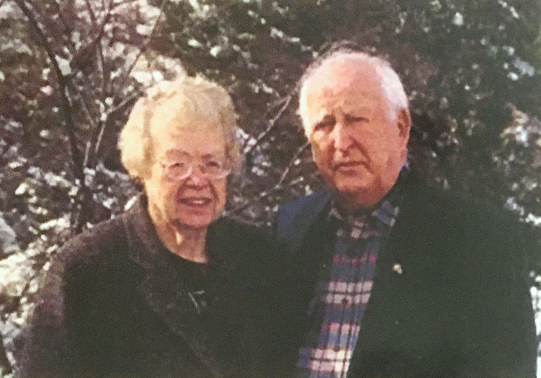
Jane and Paul Brecht, from their Christmas letters of 2000 and 2001. We are indebted to Lynn Wiand for saving these and bringing them to our attention.
Several long-time members of SCOS and NHOS remembered that Jane made a donation of orchid books and memorabilia from Paul's collection to either the Los Angeles Arboretum or The Huntington Botanical Center. We're hot on the trail of this material. After several inquiries, we discovered it was donated to The Huntington, and that it may have been part of the material that Ernest Hetherington was reviewing and cataloguing for The Huntington at the time of his death. Nothing further seems to have been done with it, but we can confirm that at least parts of this collection are still in the "orchid archive" at The Huntington Botanical Center. We hope to be able to work with Brandon Tam at The Huntington to discover what is in the Brecht archive — we're hoping to find more of our old newsletters!
Eponymous orchids: Rhyncholaeliocattleya Jane Brecht.
1983, 1984: Don Pollard
1985, 1986, 1998 (part), 1999: Dick Nerio, 1935-2000

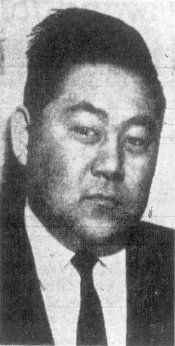
Dick Yukio Nerio, 1963 photo for Westminster Realty Board
He also served as President for Newport Harbor Orchid Society, in 1987 and 1988, and was active in a number of organizations, such as the Rotary Club. He has the distinction of being the only SCOS past president commemorated by a bronze plaque that mentions South Coast Orchid Society: our only monumental inscription so far! His wife Margaret, who still lives in Huntington Beach, served as SCOS Secretary.
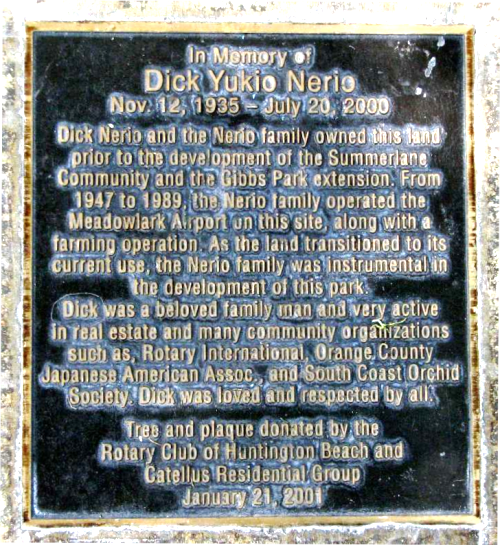
Plaque honoring Dick Nerio in Gibbs Park, Huntington Beach, CA, on the former site of Meadowlark Airport
The Nerio family (Koichi and Toyo — for some of their remarkable story, see an account of the family's 2003 gift to the Orange County Agricultural and Nikkei Heritage Museum at CSU Fullerton) purchased the property in Huntington Beach, Orange County, CA that had been known as the East Long Beach Airport (about 1946 or 47, owned by Col. Richard Willsie, a Long Beach native known for his intrepid adventured in military aviation), later as the Sunset Beach Airport, and finally as Meadowlark Airport (coordinates 33.72, -118.037), in 1952, when Col. Willsie was called back to active duty for the Korean War.
Dick and his brother Art, sons of Koichi and Toyo, managed the airport from about 1969 (the airport had previously been leased out to other operators) until it closed in September, 1989 — the property had become a target for developers, and, even though it had a large following in the private aviation community (around 300 small aircraft rented tie-down space there), it was plagued by complaints from the surrounding neighborhoods about noise and possible danger to residents. Development has since erased almost every trace of Meadowlark Airport, apart from the plaque in Gibbs Park. The rest of the property is covered with houses (Summerlane development) and shopping. The story of the airport has been documented extensively on Paul Freeman's Abandoned and Little-Known Airfields: California, Northern Orange County web site.

Mural depicting Meadowlark Airport, in a nearby Trader Joe's grocery store!
1987, 1988: Dr. Linda Miller Iger
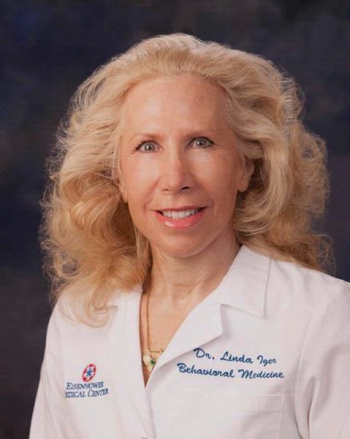
She is a psychologist specializing in clinical neuropsychology, and especially, chronic fatigue syndrome and fibromyalgia, on which she is widely regarded as a pioneer and researcher. She has won 5 AOS awards for her orchids. Her clinical practice is now based in Palm Desert, CA.
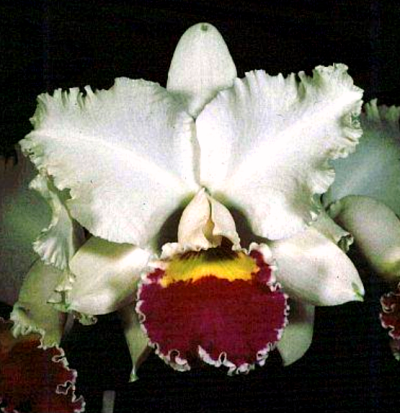
© 1984 AOS
Lc. Fair Catherine 'Iger's Lovely Lace' HCC/AOS, awarded April 7, 1984 at the South Bay Orchid Society Show in Torrance, photographer unknown
Eponymous orchids: She registered two hybrids: Dendrobium Linda Miller Iger (1984, hybridizer not listed, photo in AOS Awards Quarterly 16:107, not yet retrieved) and Rlc. Iger's Sweet Revenge (1984, hybridizer Sea God Nursery, that was Raymond Burr's orchid nursery, at least two clones are still around). Dr. Iger seems to have had a special fondness for semi-alba Cattleyas. Three of her semi-albas were awarded: Lc. Coastal Concept 'Iger's Shining Star' HCC/AOS, Lc. Fair Catherine 'Iger's Lovely Lace' HCC/AOS, and Lc. Starting Point 'Iger's Delight' HCC/AOS.
1989, 1990: Donald Edward Fraser
Don was still on our membership list in 1994, living in Whittier. He was active in SCOS at least as early as 1986.
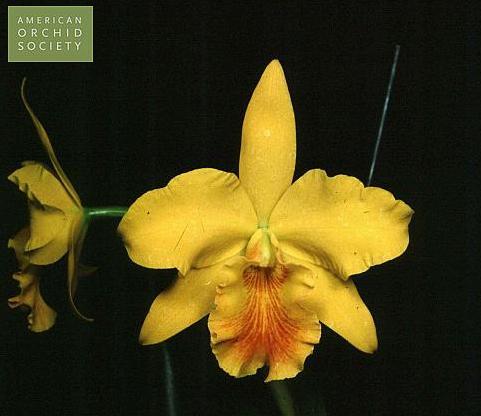
© AOS 1986
Eponymous orchid: Rhyncattleanthe Twentyfour Carat 'Fraser's Gold' HCC/AOS exhibited by Donald E. Fraser March 24, 1986 at Pacific South Monthly Judging, at our meeting.
1991, 1992, 1996: Dr. Philip David Plocher, 1926-2019
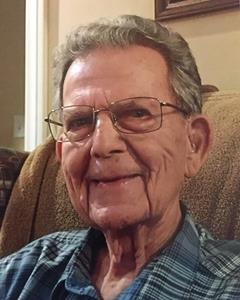
Born in Woodland, Yolo County, CA in 1926, he grew up on a dairy farm where the family raised prize-winning Holstein cows. He died in Tustin, Orange County, CA on December 1, 2019. Veterinarian, University of California at Davis, class of 1952. He moved to Long Beach, where he met and married his wife Gwendolyn Ann Cott (1938-2006). He operated the Uptown Animal Hospital at 3350 Atlantic Avenue in Long Beach for about 30 years. Tony Glinskas recalls that Phil had a beautiful greenhouse built on his property (John Reyes called it the Taj Mahal) and was an excellent grower and organizer. After he sold his veterinary hospital and his wife Gwendolyn died (2006), he moved to Orange County to be close to his son.
One of the gems that turned up as a result of our effort to recover SCOS history is a column by Ann Wilson (widow of SCOS President Woodrow C. "Woody" Wilson, see above) from our July, 1997 newsletter, a biography of Dr. Plocher:
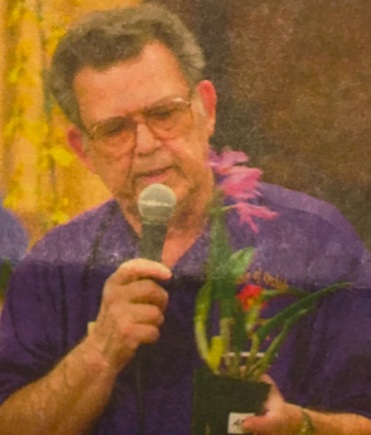
Dr. Phil Plocher, selling orchids at our 2002 annual auction
"Dr. Philip Plocher's son Brian joined South Coast when he was in junior high school. Brian had secured a license and imported orchids from Brazil. In those days, the agricultural inspector came to their home to inspect the shipment. Phil drove Brian to the meetings, but did not join until after a past president, Glenn Hamilton, had given him a nice cymbidium, of which he still has a piece. Phil is a firm believer in giving plants to novices, which often gets them started in the hobby.
"Phil's extremely green thumb was nurtured when he was growing up in Northern California on a commercial dairy farm where they also grew sugar beets, canning tomatoes, and many fruit trees. He didn't put in a greenhouse until five years ago [that would be about 1992.—Webmaster], after retiring from the veterinary hospital. He was very successful growing about 700 orchid plants outside at their home in the coastal area of Long Beach. About the only genera he couldn't grow were Dendrobiums, Dendrobium phalaenopsis, and Phalaenopsis. In 1980, he and his wife Gwen had moved from Bixby Knolls to Alamitos Heights where they now live. Phil said he had to learn all sorts of new things about growing, after moving that relatively short distance, being closer to the water now.
"Dr. Plocher was President of South Coast Orchid Society in 1991-92 and again in 1996. He has always been extremely supportive of the society and helps putting in shows at fairs and malls.
"Phil is an avid deep-sea fisherman. He goes on as long as 14-day trips out of San Diego and has caught many marlin and tuna. His next trip is scheduled for October.
"Recently he made a fantastic trip to mainland China. Climbing up on the Great Wall and walking about a quarter of a mile on top was a major part of the trip, as well as seeing the terra cotta soldiers and visiting Shanghai. He says there is construction everywhere. The country is preparing for tourists, which they want very much. Food and hotels are good. He saw no evidence of military presence. He had a change to see how the communes work while driving through the country and feels that China will Westernize and change slowly.
"The big family news for Gwen and Phil is that their daughter Amy is pregnant and their first grandchild is expected later this year."

© 2015 Arthur Pinkers
Eponymous orchids: Lynn Wiand got an HCC/AOS for her cultivar of Paphiopedilum haynaldianum, which she named 'Phil Plocher', at the judging session held at our May, 2015 meeting.
1993, 1994, 1995: Tony Glinskas
Tony has given years of his life keeping the Fascination of Orchids show going — the 39th will be here soon! We also thank him for bringing computers and the internet into our orchid society. He has made the Fascination of Orchids web site into a sort of clearinghouse for orchid activities in Southern California. Tony has kindly provided some recollections of his fascination with orchids:
"I got involved with SCOS when Newsletter Editor Art McCann needed someone to sub for him while he went on a long vacation. Art handed me a box of cutouts which he would cut and paste in the Newsletter along with typewriter copy, and then go to the Copy Store. I used computer graphics and when Art returned, he said that the group would never accept a cut-and-paste Newsletter again, and I was stuck. I also started the website and purchased the southcoastorchidsociety domain name. Somehow, I became Prez of the Club. I heard the stories of yesteryears and the great happenings at the Petroleum Club and the Long Beach World Orchid Conference which I never knew and were now history...
"Long before I brought Art McCann and SCOS kicking and screaming into the digital age, I was involved in Computer Graphics. I was even a charter member of the Computer Graphics Pioneers group in the early days of the industry. I became a sales and marketing executive in a very fast paced high-tech industry. I found myself traveling around the country and the world during the week. I needed some slow paced activity and turned to low-tech gardening.
"At that time, I had never knowingly seen a real orchid plant until one day in a florist shop. The florist saw me staring at this plant and mesmerized with the beautiful flower. The florist informed me that he was going to cut the bloom for a corsage and was willing to let the plant go at a good price if I was interested. I jumped at the deal. Took the plant home and carefully took care of it and waited for a wonderful bloom. After a few months of diligent care, I was the owner of a dead plant! Well, I thought, there are always roses and geraniums.
"One fateful day a few years later, I happened to stumble into the Huntington Beach Mall. A big sign outside advertised an orchid show. As I walked in, I caught the sight of a man in a pith helmet yelling that you can easily grow these beautiful orchids in your own backyard. I soon learned that these plants were called Cymbidium Orchids and the man in the pith helmet was Bill Austin. I had a long talk with Bill and became instant friends. He told me that I should join an Orchid Society and learn more about these exotic plants. I joined the Orange County Branch of the Cymbidium Society (CSA) and contracted non-curable Orchid Fever. I visited several orchid groups in Orange and LA counties and joined the Newport Harbor Orchid Society, the Long Beach Amateurs, and the South Coast Orchid Society (Don Fraiser was President when I joined SCOS). I soon became a Director in all of those societies. I have served as President of the Orange County Branch CSA and of the South Coast Orchid Society.
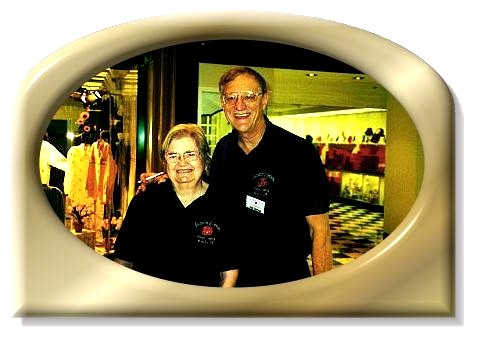
At the Fascination of Orchids show in 1998, South Coast Plaza "Crystal Court": Pat Rowland, who seems to have started the whole thing out of the Orange County Branch of the Cymbidium Society of America, and show chairman Tony Glinskas
"When I became President of the Orange County Cymbidium group, I inherited the Fascination of Orchids Show. In my former marketing roles, I had been involved in many shows and felt that the Fascination of Orchids Show could become a big attraction. I decided to expand the Show from just a few vendors to what became the largest Show in the country with only the Tokyo Dome Show being larger in the entire world! In the next few years, the show evolved, with over 400,000 visitors who came to see displays and sales by 75 vendors from 13 countries. We were looking to expand further with the addition of European Vendors and to host the Cymbidium Congress.
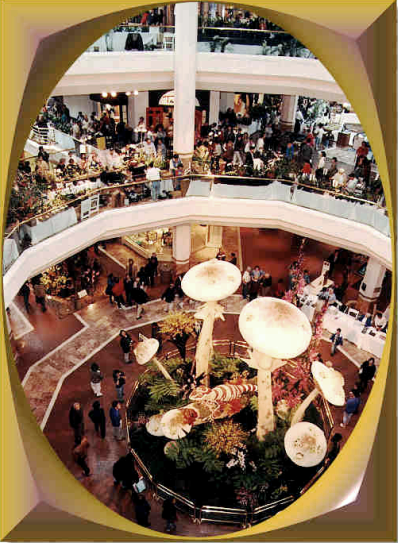
Fascination of Orchids, 1998, award-winning center display. The 12-foot long lizard had graced the United States Postal Service float in the Rose Bowl Parade a few weeks earlier. It was supplemented by mushrooms over 20' high and several thousand orchid flowers.
"The first Show was in 1981, since 2019 is the 39th year. I was not part of it back then. It was a simple cymbidium show, held where we had the Orange County CSA meetings, and was not called Fascination of Orchids. It went from a tiny show in Westminster, to the old Huntington Beach Mall. When that Mall was going belly up, Paul Brecht helped us get into South Coast Plaza. Each year, a Show Theme was selected and one of the years, not sure of when, the Theme was "The Fascination of Orchids". Everyone liked the name of the theme and henceforth the show was called "Fascination of Orchids", without the "The".
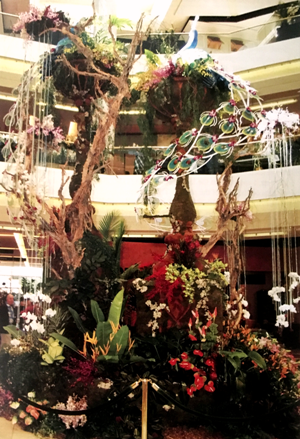
Fascination of Orchids, 2004: center display, "Secret Garden"
"Pat Rowland was the big starter for the Orange County Branch of the Cymbidium Society of America. She and her family were also instrumental in starting Newport Harbor Orchid Society. She, her husband, and their son were big orchid growers and started The Rowland Collection orchid business. They wanted to foster orchid growing in Orange County and started at least these two orchid clubs. Since The Rowland Collection was primarily cymbidiums, they wanted a club and an exhibition to show those many varieties. There weren't any exhibitions in Orange County and Santa Barbara was a journey.
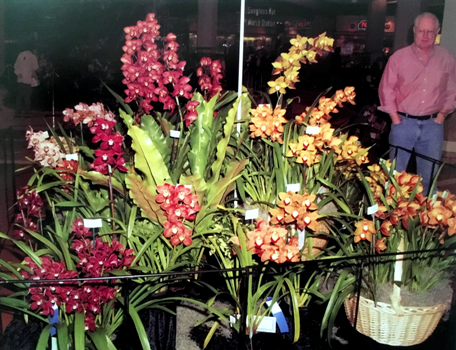
Fascination of Orchids, 2004: award-winning display by Casa de las Orquideas
"(Newport Harbor did not have any exhibitions until much, much later. Their "Oceans of Orchids" did very poorly at their Meeting place. They needed a better location. Our Fascination of Orchids group had previously held one show at Westminister Mall when I wanted to also have a Fall Show. South Coast Plaza got very upset about holding one of "their" shows in a different venue, so I dropped future shows there. However, Westminster Mall liked the idea, and when Fascination of Orchids left South Coast Plaza (2006) and left a big vacuum in the Valentine's Day time slot, NHOS saw the opportunity to finally have a better location and time slot.)
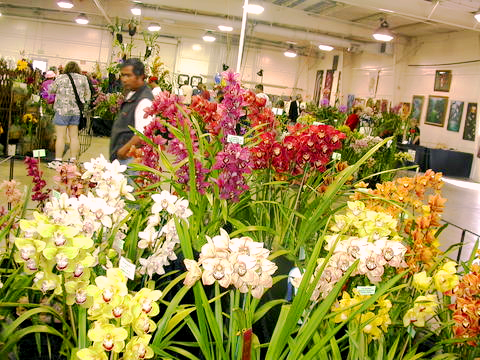
Fascination of Orchids, 2006, at the Orange County Fairgrounds
"When the show moved to South Coast Plaza, I embarked on turning it into a large international exposition. My big problem was getting publicity at a reasonable cost. ComCast said that they would support the Show with free spots during broadcasts of Headline News and CNN. They were willing to give us those spots, provided that we were 501(c)(3) certified. They put the value of that publicity at over $25,000! I asked all the leaders of CSA about this. They all stated that they were indeed certified, however, I could not get this verified by IRS or any documentation that CSA had. I finally discovered that CSA was a California nonprofit but was NOT a 501(c)(3), which would be necessary for ComCast to take a tax deduction. I had long talks with Dr. and Sandra Svoboda, who headed CSA. They advised me that the only way was to set up a separate "arm's-length" organization, as they did with the Santa Barbara Show. We did just that, with legal help, and set up Fascination of Orchids, Inc. We have operated the Show under that separate group ever since.
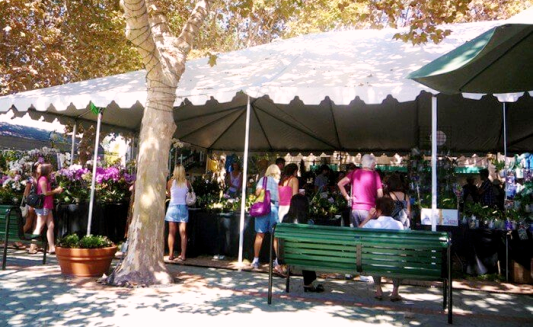
Fascination of Orchids, 2014, at South Coast Village
"The show eventually got too successful, with the City of Costa Mesa complaining of the massive traffic jams it created, as thousands of cars tried to come into the Show. The expansion of what was then called Crystal Court resulted in a massive cutback of storage space which we needed to accommodate the many vendors. We discussed using part of the parking lot, however, we were already short of parking spaces. The restaurants loved the Show as it was the busiest weekend of the year for them and that included the Holiday Season. However, the high-end merchants complained that their high-end customers were not able to cope with the crowds and the lack of parking spaces. The high-end shops won and we were asked to find another venue.
"The only places that we could move to were the Anaheim Convention Center or the Orange County Fairgrounds. Anaheim was too far and very expensive. The Fairgrounds was our choice (2006), but it turned out to also be very expensive and very difficult to work with. After a couple of years, I asked Anton Segerstrom for help to get back into South Coast Plaza. He could only offer South Coast Plaza Village. This would be an outdoor event and our February date would not work. Chose the last weekend of September which seemed safest. However, it was never the same again and I am far too old and weak to revive it... Shows take a lot of work and energy!"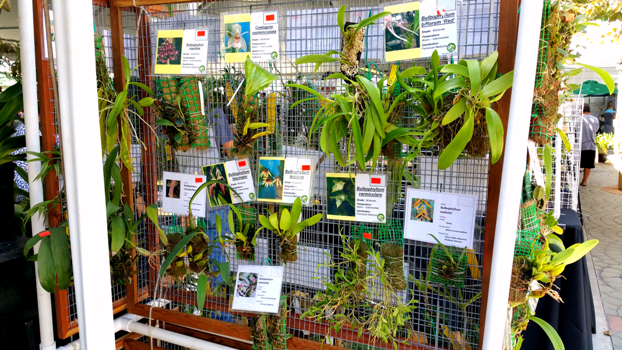
Vendor booth at Fascination of Orchids, 2015
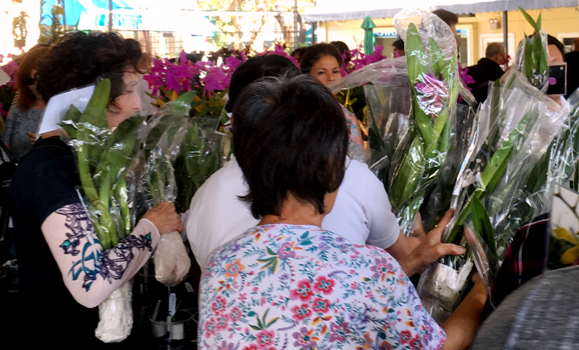
Fascination of Orchids, 2017: mob scene, everybody trying to pay for their orchids at the same time
In 2005, the CSA Journal published an article by Tony about the 2004 Fascination of Orchids show, which described something of the behind-the-scenes activity: "The Fascination of Orchids Show preparation never stops. Around forty hard-core show committee members perform their labor of love the year round making this show a little better. Almost a year in advance, the crew decided on a show theme, design of a show pin, a show poster, and that all important — what color will be the show shirt." One team had the difficult job of selecting vendors for the show: so many vendors wanted to participare, that there was a waiting list. Another team was devoted to evaluating the sales area for such factors as appearance, containment, quality, operational flexibility, and how each display contributed to show diversity. At that time, the show was still in the Crystal Court, and the show committee worked with an equally busy crew from the South Coast Plaza management. Even back then, Tony was already worried that the show was so big it could not be sustained indefinitely.
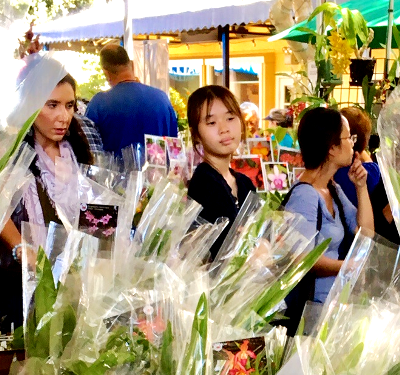
Fascination of Orchids 2018: serene faces in the crowd—absolutely fascinated!
Perhaps today's Fascination of Orchids is tiny by comparison with what it has been, but it still evokes some serious orchid madness. Hordes of orchid enthusiasts swarm through the booths. Does anyone need further proof that the orchid hobby is alive and well? Hints for first-timers: delay your arrival until about noon, to avoid the initial crush of people who are afraid they might miss out on something. Bring a couple plastic shopping bags, rather than a cart or wagon—there just isn't room for wheels! Bring cash, because some vendors aren't set up for credit cards, or their credit card scanner isn't working, and besides, cash transactions are often much faster. Be very patient so that you can talk to as many vendors as possible: they are interesting people, even if seriously stressed by the crowds! Be gracious, compliment them on their plants, and thank them for taking the time to help you! You will probably (literally) run into or trip over people you know from SCOS meetings; be as polite as possible towards all of the crazy orchid people and their unsuspecting friends when you collide.
The Orange County Branch of the Cymbidium Society of America eventually morphed into the Cool-Growing Orchid Society (2014), but that's another story. Will the history of their time with Cymbidiums be preserved?
1996: Dr. Phil Plocher, see above
1997, 1998 (part): Jimi Fox
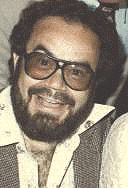
When Jimi Fox found SCOS, he was well known around Southern California as a radio personality and actor, and he was clearly very enthusiastic about Cymbidiums. As a radio engineer (he was actually the program director at KTNQ/"TenQ" in Los Angeles, a radio station featured in the movie), he turned up on film (uncredited) in Grand Theft Auto (1977). He made a short film about growing Cymbidiums (1992), which we have never seen, with Everett Stockstill, of Harbor City, a Cymbidium grower also featured in a Los Angeles Times article on March 17, 1990, and Bert Tagami, one of the founders of the Torrance Cymbidium Club, featured in an online post December 27, 2013 in the Rafu Simpo Los Angeles Japanese Daily News. In the 1980's, he set up a company called Orchids Limited International in Carson, for which he had great hopes. Fortune, however, was not so kind; he is said to have lost a lot of money in this venture, but not for lack of trying. He was also active in the Torrance Cymbidium Club and registered a number of hybrids under his company's name.
The economics of the orchid business are unforgiving. At the time Orchids Limited failed, the industry was in a state of upheaval. Relatively few orchid breeders found the right combination to succeed, as the demand for prize-winning Cymbidiums gave way to the phenomenon of the "grocery store orchid". The history of SCOS is full of orchid enterprises that delighted and thrilled us, but which nevertheless did not endure. Some were perplexed that Jimi "disappeared" and "changed his name" to Norbert Gomes (when he left SCOS before the end of his second term as President — but Jimi Fox was only his stage name, all along — not such an unusual occurrence, given our proximity to Hollywood, and in a hobby historically associated with celebrities besides). His enthusiasm and creativity are evident in our newsletters from his tenure.
As for the registrations, some 287 hybrids were registered between 1992 and 2000 by Orchids Limited International, mostly Cymbidiums, but there are also six Paphs, one called Paph. Norbert Gomes, registered in 2000 (Paph. insigne × Winston Churchill), a very logical cross for someone to try, given the success of Paph. Winston Churchill as a parent. Of those 287 registrations, 97 list Orchids Limited International as the originator. Of those 97, four were registered in 1992 by Mrs. Patrice Gomes of Redondo Beach (Jimi's wife). Of the 190 hybrids registered by Orchids Limited International that were created by others, they came from a wide variety of breeders, such as William D. Bailey (Bill Bailey's Orchids, Palos Verde Estates, these were mostly registered in 1992-1994), Clark Day, Jr. (well known as a member of SCOS, four Paphs, registered in 1999), Dos Pueblos Orchid Co. (eight Cymbidiums registered in 1998), and especially, 98 created by Geyserland Orchids (owned by Andy Easton, most of these were registered in the 1990's). Over 70 of these registrations received awards, mainly from the Cymbidium Society of America. About a dozen Cymbidiums, not necessarily registered by Orchids Limited International, were exhibited and awarded at AOS judging at our monthly meetings in 1998 and 1990, and the company's exhibits at local shows were well received.
In 1990, when he was our First Vice-President, Jimi was the author of a short piece in the Los Angeles Times (March 3, 1990) under the title "The Aristocratic Orchid Casts a Spell of Beauty and Elegance", with some general information about growing orchids as house plants or outdoors, ending with this plug for local orchid clubs: "Under the flag of the American Orchid Society, hundreds of small community orchid societies exist across the country. The purpose of these societies is the preservation of orchids by sharing the experience of growing these most elegant plants."
In our October, 1993 newsletter, we found an advertisement for the "Fifth Annual Fall Open House & Cymbidium Spike-a-Thon" by Orchids Limited International, to be held November 27-28 in Carson ("Supplies and Repotting, Open 9 to 5 Every Day").
At length, we found a short bio and snapshot to set the record straight (laradio.com): "FOX, Jimi: KTNQ, 1976-77. When Jimi got out of his daily involvement with radio, he followed his hobby and second love — orchids. He grew world class highly awarded orchids and has been responsible in setting new trends in hybridizing. "I've registered countless plants using rock 'n' roll identities, such as 'Itchycoo Park,' 'Amos Nitrate,' and 'Electric Ladyland,' the last of which now graces the label of an international orchid fertilizer." Born Norbert Gomes, Jimi started his radio work on KDES-Palm Springs. In early 1970 he was pd [ program director ] and midday air personality at KENO-Las Vegas. A year later, Jimi went to KIKX-Tucson to be pd and evening jock. In 1973, he joined Buzz Bennett at KRIZ-Phoenix as md and evening personality and before the year was out had moved to KUPD-Phoenix. Late in 1974 Jimi helped Bobby Rich put KFMB (“B-100”)-San Diego on the air. He did weekends and acted as pd for the debut of "the new Ten-Q" on December 26, 1976. After leaving KTNQ, Jimi went to KCBQ-San Diego as pd. He then joined Mercury Records as vp of national promotions and was the radio editor for Cash Box Magazine."
Today he is President and CEO of HookCity Productions, and describes himself in his Linkedin profile as "retired broadcaster, journalist, active designer, photographer, author and dreamer", living in Redondo Beach. When someone posted a query about "what ever happened to Jimi Fox" on an online Los Angeles radio bulletin board, there was a response from Pat Gomes giving the correct spelling of Jimi, and another from Norbert Gomes, "I see him every day".
We Are Their Only Hope!
We remarkably praise the celestial great gardener;
As his creations of beauty and color come alive;
Kindly, entranceways expose naturally elegant and serene gardens;
Appreciate the moist beauty each puissant yet fragile rain forest has to offer.Nature's natural hybrids, triumphantly adorn each and every eloquent jardin;
Species command attention, polarization of beauty abounds.
Behold the laelias reaching upward for the sun, each an undaunted exhibitionist!
Amusing cattleyas cling, secured gracefully to the limbs and bark of far-reaching trees.An encyclia laughs in the breeze, its confidence unyielding.
A newly born epidendrum sleeps, confidently aware of the coming of the morning light.
Bits of small bark and loose leaves, cleverly insulate a wet rooted phalaenopsis.
A timid oncidium contently and silently dreams, a seed bank in the making.Nature evolves, a ramshackled paphiopedilum gives way to a new enriched paphiopedilum.
There are the great gardener's gift of orchids to all mankind;
Majestic global gardens everywhere, survivors of prehistoric times.
Time that has preceded mankind, time that shall survive mankind!Yet, with all this beauty, has mankind shown approbation?
I fear not, for plundering, rape and uncontrolled destruction prevail!
What man are you, what cold heart are you to forsake nature's beauty?
Who dare pulverize an orchid wilfully, from its habitat?Tropical forests under siege, no salvage in sight to be seen.
A cypripedium trembles, life ends as the jungle floor is engulfed in blusterous burning.
Smoldering ground ashes, a seed pod forever dormant lost in the scorched bosom of mother earth.
Brutal destruction of the species; is not this rage tragic and tyrannical?Who will take a stand, as tormented tears are shed?
What single man can and will cultivate those perished species, decadently destroyed?
Will one stand alone, confronting those responsible for the plundering of Brazil or Borneo to mention only two?
Who, who amongst us will cleverly propagate the future with nature's lost orchids?Look not at this poem, for it is but a symbol not the answer.
Look deep in your heart, reach out to others with the answer of truth formed by your lips;
Confront the deaf, magnify that truth for the blind;
Speak loudly, become if you must, abhorrent for the cause of orchid conservation!Discover organizations, The American Orchid and Royal Horticultural Societies, the vehicles who truly care.
Speak not just as one voice, but a global multitude sparing few if any words;
Fear not to speak to any class of individuals, like you even the world leaders were born equally bare!
Time is of essense, time is now, we are the catalyst that must blow out the fire and save the beleaguered orchids.We Are The Only Hope!
— Jimi Fox (AOS Bulletin 59(12):1250 (1990))
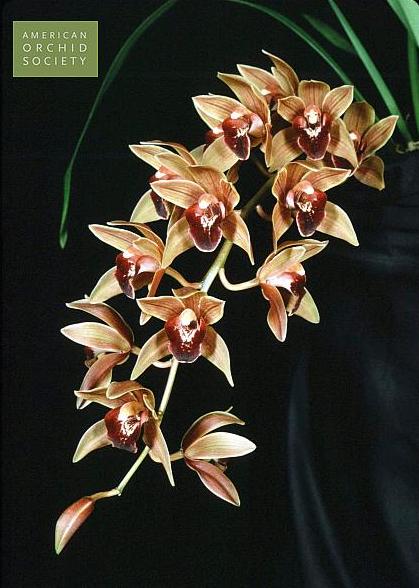
© AOS 1994
Cymbidium Jimi Fox 'Vegas Vagabond' HCC/AOS, awarded at the 1994 South Bay Orchid Society Show, March 4, 1994, exhibited by Orchids Limited.
Eponymous hybrid: Cymbidium Jimi Fox, created and registered by Keith Andrew Orchids 1991, cultivar 'Vegas Vagabond' received an HCC/AOS award in 1994 at the South Bay Orchid Society Show.
1998 (part), 1999: Dick Nerio, see above
2000, 2001, 2002, 2003, 2004, also 2012, 2013, 2014, 2015, 2016, 2017, 2018, 2019: John Reyes
2005, 2006: Ruben Colmenares
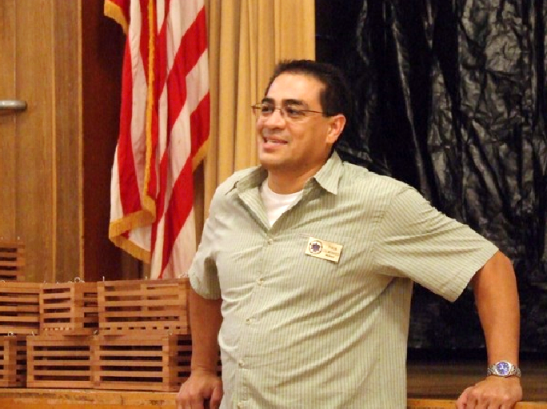
Ruben introduced himself in our newsletter at the beginning of his first term as President: "Orchids have been with me for most of my life. As a young boy, I was fascinated by plants, and I was introduced to orchids as a birthday gift from my mother—a Paphiopedilum that I admired—and as one thing led to another, I’ll admit, I became orchid-obsessed! I aspired to become an orchid botanist in my early years, and took jobs in orchid nurseries and greenhouses to learn more about orchids. I found that orchids are among the most adapted, evolved, and complex family of blooming plants on the planet. No matter how much or little you may know about these fascinating plants there is always more. Although botany did not become my life’s work, I continue to be involved with orchids as my primary hobby, and naturally with the people that grow them."
Professionally, Ruben has carved out a career in public safety, as a Fire Prevention Analyst in the Orange County Fire Authority's Planning and Development Services Section since late 2001. He was previously employed and trained as a professional planner with 23 years of combined experience in the community development and building industries, and now specializes in all aspects of plan review. The mission of the Authority and its partner agencies is to reduce injuries, deaths and fire losses by building and maintaining safe communities — a challenging job if ever there was one!
Curiously, he is not the only SCOS past president to have made a career of fire safety! See above, Charles V. Stockham, our president in 1967 and 1968, who was a Captain with the Long Beach Fire Prevention Bureau. And we know of at least one Fire Chief in Orange County, Jan Briscoe, who was an avid orchid grower in the 1960's.
Ruben served as 1st Vice-President before becoming SCOS President. He had arranged a super program for February 23, 2004, featuring Dr. Helmut Röhrl, Professor of Mathematics at University of California San Diego (known for his analysis of "totally convex spaces", which sounds pretty strange to us!), when away from the chalkboard one of the great experts and hybridizers of orchids of the Oncidium alliance. However, in the next SCOS newsletter, March, 2004, we were alarmed to read: “Ruben had a great program planned. However, our speaker, Helmut Röhrl, experienced a medical problem half-way through his presentation and was taken to the hospital by the paramedics.” President John Reyes spoke with Helmut and his wife the next day and reported he was doing fine. Helmut recovered and went on to another full decade of orchid adventures and amazing contributions to the orchid world, even doing a return lecture for SCOS in June, 2008, until his death in 2014. However, all 1st Vice-Presidents now have the recurring nightmare of the featured speaker falling ill during the program, as well as all the other misadventures that could happen!
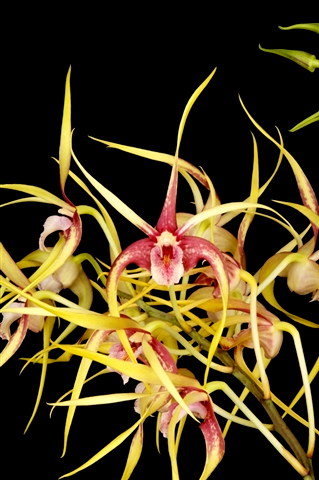
Dendrobium Ruben Colmenares 'Ruby Flare' HCC/AOS
Eponymous orchids: Fred Clarke has named a Dendrobium after Ruben! D. Ruben Colmenares 'Ruby Flare' (Regal Gillieston × Hilda Poxon), with 4" very spidery flowers, was awarded an HCC at the Long Beach supplemental judging center during the SCOS meeting of January 18, 2016.
2007: Jim F. Miller
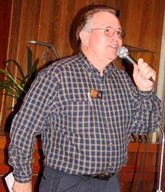
Jim Miller at his inauguration as SCOS President, January, 2007

At the 2007 annual auction, November, 2007
He was President of Newport Harbor Orchid Society in 2006. While he has since moved to Arizona, he has kept in touch with his orchid friends in Southern California. Among other businesses, he has been a dealer in after-market parts for Mercedes-Benz cars. He is presently active in the Desert Valley Orchid Society in Phoenix, Arizona, where his enthusiasm and exerience are much appreciated.
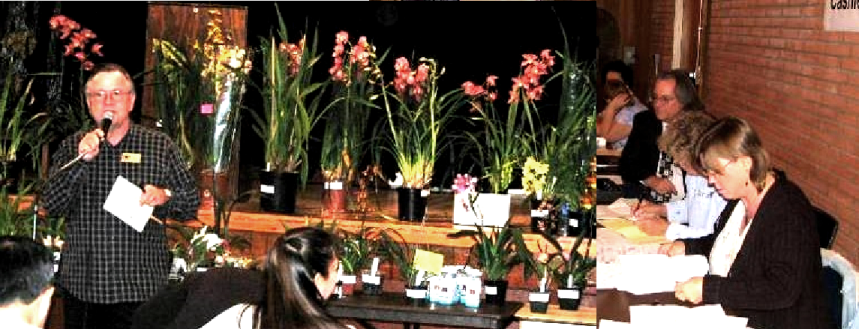
During his first few months as SCOS President, he had to deal with an unexpected increase in the rent for our meeting room at Whaley Park (successfully negotiated a 30% reduction, as reported in our newsletter) and a number of unexpected personnel changes. He also managed to shepherd a major revision of our By-Laws through the approval process. There was also a hastily-arranged change of venue for the May meeting. All of the administrivia from this period could not have been much fun, but he was always cheerful!
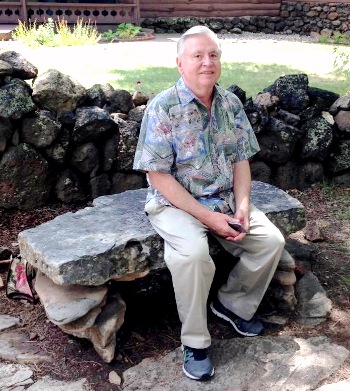
2008, 2009, 2010, 2011: Russ Nichols
2012, 2013, 2014, 2015, 2016, 2017, 2018, 2019: John Reyes, see above
Copyright 2021 South Coast Orchid Society, Inc.